生物降解塑料中英文对照
The science of biodegradable plastics
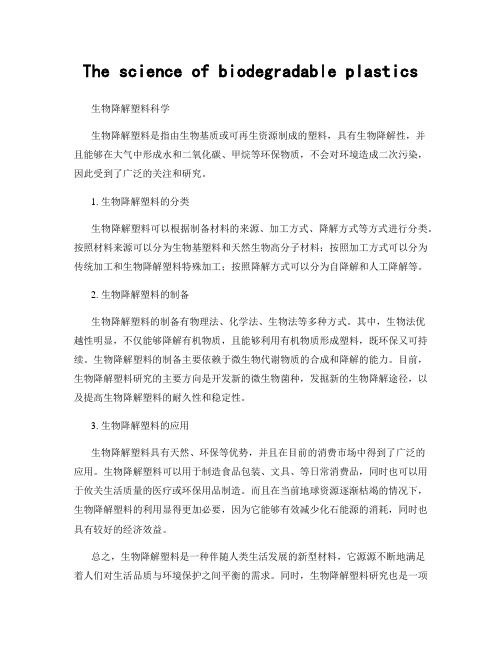
The science of biodegradable plastics生物降解塑料科学生物降解塑料是指由生物基质或可再生资源制成的塑料,具有生物降解性,并且能够在大气中形成水和二氧化碳、甲烷等环保物质,不会对环境造成二次污染,因此受到了广泛的关注和研究。
1. 生物降解塑料的分类生物降解塑料可以根据制备材料的来源、加工方式、降解方式等方式进行分类。
按照材料来源可以分为生物基塑料和天然生物高分子材料;按照加工方式可以分为传统加工和生物降解塑料特殊加工;按照降解方式可以分为自降解和人工降解等。
2. 生物降解塑料的制备生物降解塑料的制备有物理法、化学法、生物法等多种方式。
其中,生物法优越性明显,不仅能够降解有机物质,且能够利用有机物质形成塑料,既环保又可持续。
生物降解塑料的制备主要依赖于微生物代谢物质的合成和降解的能力。
目前,生物降解塑料研究的主要方向是开发新的微生物菌种,发掘新的生物降解途径,以及提高生物降解塑料的耐久性和稳定性。
3. 生物降解塑料的应用生物降解塑料具有天然、环保等优势,并且在目前的消费市场中得到了广泛的应用。
生物降解塑料可以用于制造食品包装、文具、等日常消费品,同时也可以用于攸关生活质量的医疗或环保用品制造。
而且在当前地球资源逐渐枯竭的情况下,生物降解塑料的利用显得更加必要,因为它能够有效减少化石能源的消耗,同时也具有较好的经济效益。
总之,生物降解塑料是一种伴随人类生活发展的新型材料,它源源不断地满足着人们对生活品质与环境保护之间平衡的需求。
同时,生物降解塑料研究也是一项富有挑战性的科学研究,无论是从基础理论上还是从应用实践上,都有大量的研究价值。
纸业专业英语词汇翻译(D2)
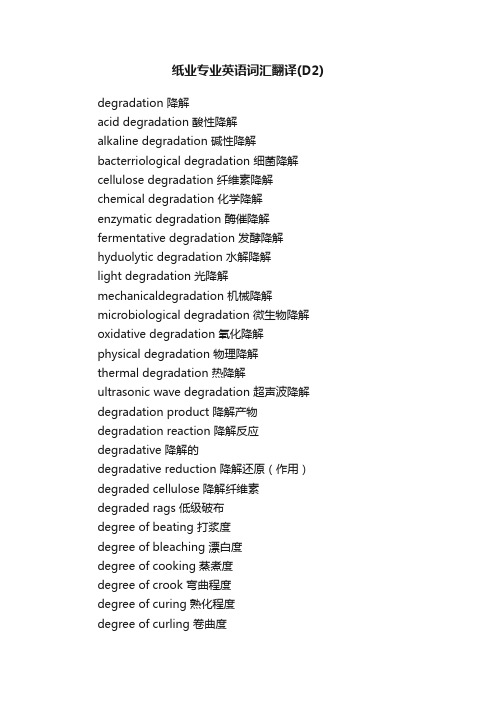
纸业专业英语词汇翻译(D2)degradation 降解acid degradation 酸性降解alkaline degradation 碱性降解bacterriological degradation 细菌降解cellulose degradation 纤维素降解chemical degradation 化学降解enzymatic degradation 酶催降解fermentative degradation 发酵降解hyduolytic degradation 水解降解light degradation 光降解mechanicaldegradation 机械降解microbiological degradation 微生物降解oxidative degradation 氧化降解physical degradation 物理降解thermal degradation 热降解ultrasonic wave degradation 超声波降解degradation product 降解产物degradation reaction 降解反应degradative 降解的degradative reduction 降解还原(作用)degraded cellulose 降解纤维素degraded rags 低级破布degree of beating 打浆度degree of bleaching 漂白度degree of cooking 蒸煮度degree of crook 弯曲程度degree of curing 熟化程度degree of curling 卷曲度degree of dispersion 分散程度degree of fermentation 发酵程度degree of hydration 水化度degree of non-combustibility 不可燃烧度degree fo non-flammability 不可燃烧度degree of orientation 定向(程)度,取向度degree of polymerization 聚合度degree of redution 还原率degree of saturation 饱合度degree of sizing 施胶度degree of slippiness 滑脱度degree of substitution 取代度degree of wetness 湿润度degree of whiteness 白度degum 脱胶dehumidifier 减湿器dehmidify 减湿dehydrate 脱水dehydrater 脱水器;脱水剂dehydrating agent 脱水剂dehydration 脱水(作用)dehydro-abietic acid 脱氢松香酸dehydrogenation 脱氢(作用)deink 脱墨deinded newspuint 脱墨新闻纸deinded stock 脱墨浆料deinked waste 脱墨废纸deinking 脱墨deionization 消除电离作用delaminate 脱层delaminated clay 涂布粘土delamination 脱层(作用)delamination resistance 抗脱层性能delay time 延迟时间delignification 脱木素(作用)dilignify 脱木素delimbing 砍伐枝桠deliquescence 潮解delivery 输送delivery gate 分送闸板delivery pipe 输送管delivery roll 输送辊,传递辊deita former 三角形长网成形器dcita wood 多层木dclthirna size 冷法松香胶deluge nozzle 压力喷嘴deluge tower 烟道气洗涤器deluge tower fume collector 塔式集尘器dilustering 褪光泽deluxe refiner 圆筒形精浆机demarcation 分界demethylation 脱甲基(作用)demy 英国纸张尺寸标准demy scale 象限秤den (打浆机)底刀座denaturant 变性剂denatured alcohol 变性酒精denaturing agent 变性剂dendrology 树木学denim cuttings 裁切布边dennison wax cennison 蜡棒dennison wax test dennison 蜡棒起毛试验dense timber 紧密木材dense wood 紧密木材densification 增浓(作用)densified laminated wood 硬化层秋材densimeter 密度计density 密度density measurement 测量密度density meter 密度计densometer 密度计;透气度测定仪denude 去污;溶蚀deodar ceder (cedrus deodara loud.) 雪松deodorization 除臭(作用)deodorize 除臭deodorizer 除臭器deoxidize 脱氧department 部门;车间depickling 脱酸depither 除髓机depithing 除髓depithing maching 除髓机deplete water 废水depolarization 去极(化)作用;消磁(作用);消偏振(作用)depolymerize 解聚depolymerizing agent 解聚剂deposit 沉积;沉积物deposition 沉积(作用)depot 储存;基地depreciation 折旧depth 深度depth of burring 刻石深度deragger (水力碎浆机)绞绳装置derivative 衍生物dermatogen 表皮原质dermatosomen 原皮质descabing 去除瑕疵descending chromatography 下行色谱法desensitization 减敏感作用desert gum(eucalytus rudis) 野桉desiccant 干燥的;干燥剂desiccate 干燥desiccate wood 烘干木材deseccating agent 干燥剂desiccation 干燥(作用)desiccative 干燥的desiccator 干燥器design 设计;计算;计划;装置design data 设计数据;设计资料design roll 水印辊design speed 设计速度designation number 标志数;标准指数desk calculator 台式计算器desorption 解吸destrutive distillation 干馏,分解蒸馏desuperheater 过热(蒸汽)降温器details 细节;零件;元件detection 检测;检验;探测detergent 去垢剂;去污剂deteriorate 降低;退化;损坏;消耗;变质deterioration 降低;退化;损坏;消耗;变质detoxicate 解毒;去除污染detoxication 解毒;去除污染detoxification 解毒;去除污染detoxify 解毒;去除污染developer 显影剂development of strength propcrties 纸张强度发展特性,纸张强度增特性devil 除尘机devillicate 帚化纤维,分裂纤维dew point 露点dewater 脱水dewatering 脱水,去水dewatering cylinder 脱水圆网dewatering drum 脱水转鼓dewaxing 脱蜡dextrin(e)(gum) 糊精dextrose 右旋糖;葡萄糖diagnosis 判断;诊断diagonal cutter 斜向裁切机diagonal grain 直纹dial 刻度盘;调节控制盘;拨号盘;二醛dial micrometer 测微仪,千分刻度盘;厚度千分仪dialdehyde cellulose 双醛纤维素dialdehyde starch 双醛淀粉dialysis 渗析diameter accretion 直径增长diameter class 径级diameter increment 直径增量diamond 金刚石,菱形diamond cut burr 菱形刻石刀diaphanometer 不透明度测定diaphragm 隔膜;薄膜diaphragm pump 隔膜泵diaphragm screen 平板筛浆机,平筛diatom 硅藻diatomaceous earth 硅藻土diatomaceous silica 硅藻土datomite 硅藻土diazo compound 重氮化合物diazo coupling 重氮偶合diazotization 重氮化(作用)diazotized compound 重氮化合物dibasic aluminum monorosinate 单松香酸铝二代盐dichloroethane 二氯乙烷dichloromethane 二氯甲烷dicotyledon 双子叶植物dicotyledonous 双子叶木材dicyandiamide 双氰胺,二聚氨基氰die 模;塑模die casting 模铸die cut 打孔;模切,冲动die cut box 打孔纸箱die cut card 打孔卡die cut liner 打孔衬里纸die cut ragchine 模压切割机die cutter 模压切割机die cutting 打孔;模切,冲切die embossing 模压印花die stamping 模压印花dielectric 介电dielectric constant 介电常数dielectric drying 介电干燥dielectric heating 介电加热dielectric loss 介电损失dielectric properties 介电性质dielectric strength 介电强度dielectrical properties 介电性质dielectric strength 介电强度dielectrical properties 介电性质diethyl ether 二乙醚difference spectrum 差异光谱differential draw indicater 差动牵引指示计differential drive 差速传动differential flowmeter 差示流量计differential gear 差动齿轮differential manometer 差示压力计differential pressure regulator 差动压力调节器differential valve 差动阀differential winder 差动复卷机diffraction 绕射,衍射diffuse 扩射;漫射diffuse blue reflectance fator 蓝光扩散反射系数(即iso亮度)diffuse (in aggregates)parenchyma 星散薄壁细胞diffuse porous wood 散孔木diffuse 扩张器;浸渍器;扩散洗涤器diffuse washer 扩散洗涤器diffuse washing 扩散洗涤diffusion 扩散作用diffusion-extraction method of blowing 扩散抽液法喷放diffusion washer 扩散洗涤器diffusion washing 扩散洗涤diffusion zone 扩散区digest 蒸煮digester 蒸煮器digester acid 蒸煮酸digester blow test 蒸煮终点测定digester brick 耐酸砖digester capacity 蒸煮锅容积digester charge 蒸煮锅装料digester charging 蒸煮锅装料digester charging floor 蒸煮锅装料楼面digester circulating system 蒸煮药液循环系统digester circulating 蒸煮药液循环digester controller 蒸煮(程序)控制装置digester cycle 蒸煮周期digester filling 蒸煮锅装料digester fittings 蒸煮锅管件digester head 蒸煮锅锅口digester house 蒸煮车间digester (inside) test 放气前蒸煮液分析digester lining 蒸煮锅衬里digester liquor 蒸煮液digester neck 蒸煮锅锅颈digester operater 蒸煮锅生产能力digester relief (蒸煮锅)放气;放气管路digester room 蒸煮车间digester shell 蒸煮锅锅壳,锅壁digester side relief 蒸煮锅侧面放气管路digester silo 蒸煮锅顶料仓digester steaming 蒸煮锅通汽digester tile 耐酸砖digester top relief 蒸煮锅锅顶放气digester yield 蒸煮得率,粗浆得率digesterman 蒸煮工digesting 蒸煮digestion 蒸煮digestion liquor 蒸煮液digestion operating curve 蒸煮曲线digestion time 蒸煮时间digger 挖浆机digging machine 挖浆机digging of pulp 挖浆digital computer 数字计算机digital speed/draw system 车速和牵引力的数字控制系统digital system 数字系统digitrac 数字控制器dihydro-abietic acid 二氢化松香酸di-isocyanate 二异氰酸盐dilatancy 膨胀性能dilatant 膨胀剂diluent 稀释剂dilute 稀释dilute acid 稀酸dilute solution 稀溶液dilution 稀释dilution factor 稀释因子dilution water 稀释(用)水dilution well 稀释槽。
塑料制品行业中日英文单词对照
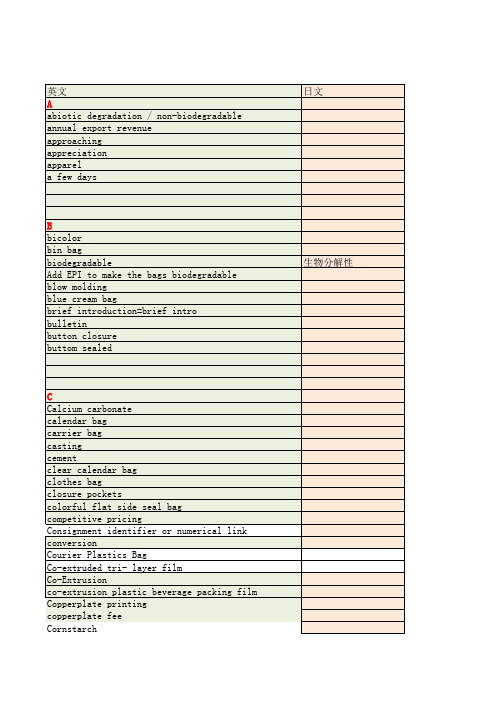
G garbage garment bag grocery garbage garden bag gusset given name
H hand lenth handle handle bag handle plastic shopping bag have own export license heat seal HDPE clear umbrella bag HDPE LDPE color printing soft loop home appliance hቤተ መጻሕፍቲ ባይዱusehold
Cutlery
Rectangular Ribbed Containers Rectangular G Containers Miscellaneous
Round Containers
Drinking Cups
spork Trash Bags
中文 非生物降解 年出口收入 接近,逼近 衣服
双色 垃圾袋 生物降解的 通过添加剂EPI (2%)使袋子降解 吹塑成型 蓝霜袋 简介 公告 按钮关闭,纽扣封口 底封
垃圾,垃圾桶 服装袋 杂货店,食品杂货店 垃圾袋 花园垃圾袋子 琴位 教名
手宽提手 手提袋 塑料手提袋子 具有自主出口权 热封 HDPE 透明雨伞袋 HDPE LDPE彩色印刷柔软环状 家电 全家人,家庭,家族,家常的,日常的
注射成型 相互影响 英国公司增值税
肯尼亚 猕猴桃
层压材料 复合袋 层压薄膜,叠压薄膜 adj.合法的,合理的;正规的;合法婚姻所生的;真正的, 真实的 唇位 散装 LDPE 卷装复合膜
磁带袋子 与。。。合作,协力,作为团队合作,联手 暂时 背心袋 三层共挤膜 半透明的 透明的 透明的 垃圾袋
运费付讫,运费向收货人索取,到付 单色 阿联酉,阿拉伯联合酋长国 紧急的 美国零售巨头
塑料大全中英文对照-打印版

ABS Acrylonitrile-butadiene-styrene 丙烯腈/丁二烯/苯乙烯共聚物AES Acrylonitrile-ethylene-styrene 丙烯腈/乙烯/苯乙烯共聚物AS Acrylonitrile-styrene resin 丙烯腈/苯乙烯共聚物ASA Acrylonitrile-styrene-acrylate 丙烯腈/苯乙烯/丙烯酸酯共聚物CA Cellulose acetate 醋酸纤维塑料CE "Cellulose plastics, general" 通用纤维素塑料CF Cresol-formaldehyde 甲酚-甲醛树脂CMC Carboxymethyl cellulose 羧甲基纤维素CN Cellulose nitrate 硝酸纤维素CPE Chlorinated polyethylene 氯化聚乙烯CPVC Chlorinated poly(vinyl chloride) 氯化聚氯乙烯EP "Epoxy, epoxide" 环氧树脂EPM Ethylene-propylene polymer 乙烯/丙烯共聚物EPE Expanded Polyethylene可发性聚乙烯(珍珠棉)EPS Expanded polystyrene 可发性聚苯乙烯(宝丽龙)EVA Ethylene/vinyl acetate 乙烯/醋酸乙烯共聚物HDPE High-density polyethylene plastics 高密度聚乙烯HIPS High impact polystyrene 高抗冲聚苯乙烯IPS Impact-resistant polystyre ne 耐冲击聚苯乙烯K树脂 Styrene- butadiene 苯乙烯/丁二烯共聚物LCP Liquid crystal polymer 液晶聚合物LDPE Low-density polyethylene plastics 低密度聚乙烯LLDPE Linear low-density polyethylene 线型低密聚乙烯LMDPE Linear medium-density polyethylene 线型中密聚乙烯MBS Methacrylate-butadiene-styrene 甲基丙烯酸/丁二烯/苯乙烯共聚物MC Methyl cellulose 甲基纤维素MDPE Medium-density polyethylene 中密聚乙烯MF Melamine-formaldehyde resin 密胺-甲醛树脂MPF Melamine/phenol-formaldehyde 密胺/酚醛树脂PA Polyamide (nylon) 聚酰胺(尼龙)PAE Polyarylether 聚芳醚PAEK Polyaryletherketone 聚芳醚酮PAI Polyamide-imide 聚酰胺-酰亚胺PAK Polyester alkyd 聚酯树脂PAN Polyacrylonitrile 聚丙烯腈PASU Polyarylsulfone 聚芳砜PAT Polyarylate 聚芳酯PAUR Poly(ester urethane) 聚酯型聚氨酯PB Polybutene-1 聚丁烯-[1]PBT Poly(butylene terephthalate) 聚对苯二酸丁二酯PC Polycarbonate 聚碳酸酯PE Polyethylene 聚乙烯PEEK Polyetheretherketone 聚醚醚酮PEI Poly(etherimide) 聚醚酰亚胺PEK Polyether ketone 聚醚酮PES Poly(ether sulfone) 聚醚砜PET Poly(ethylene terephthalate) 聚对苯二甲酸乙二酯PEUR Poly(ether urethane) 聚醚型聚氨酯PF Phenol-formaldehyde resin 酚醛树脂PI Polyimide 聚酰亚胺PMMA Poly(methyl methacrylate) 聚甲基丙烯酸甲酯PMS Poly(alpha-methylstyrene) 聚α-甲基苯乙烯POM "Polyoxymethylene, polyacetal" 聚甲醛PP Polypropylene 聚丙烯PPO Poly(phenylene oxide) deprecated 聚苯醚PP-R Polypropylene randon coplymer 无规共聚聚丙烯PPS Poly(phenylene sulfide) 聚苯硫醚PPSU Poly(phenylene sulfone) 聚苯砜PS Polystyrene 聚苯乙烯PSU Polysulfone 聚砜PTFE Polytetrafluoroethylene 聚四氟乙烯PU(或PUR)Polyurethane 聚氨酯PVAL Poly(vinyl alcohol) 聚乙烯醇PVC Poly(vinyl chloride) 聚氯乙烯PVCC chlorinated poly(vinyl chloride)(*CPVC) 氯化聚氯乙烯RP reinforced plastics 增强塑料RTP reinforced thermoplastics 增强热塑性塑料S/AN styrene-acryonitrile copolymer 苯乙烯/丙烯腈共聚物SBS styrene-butadiene block copolymer 苯乙烯/丁二烯嵌段共聚物SMC sheet molding compound 片状模塑料S/MS styrene-α-methylstyrene copolymer 苯乙烯/α-甲基苯乙烯共聚物TMC thick molding compound 厚片模塑料TPE thermoplastic elastomer 热塑性弹性体TPU thermoplastic urethanes 热塑性聚氨酯PVDC Poly(vinylidene chloride) 聚(偏二氯乙烯)PVDF Poly(vinylidene fluoride) 聚(偏二氟乙烯)SAN Styrene-acrylonitrile plastic 苯乙烯/丙烯腈共聚物SB Styrene-butadiene plastic 苯乙烯/丁二烯共聚物Si Silicone plastics 有机硅塑料SMS Styrene/alpha-methylstyrene plastic 苯乙烯/α-甲基苯乙烯共聚物TPE Thermoplastic elastomer 热塑性弹性体UF Urea-formaldehyde resin 脲甲醛树脂UHMWPE Ultra-high molecular weight PE 超高分子量聚乙烯UP Unsaturated polyester 不饱和聚酯。
塑料常用中英文名称对照表
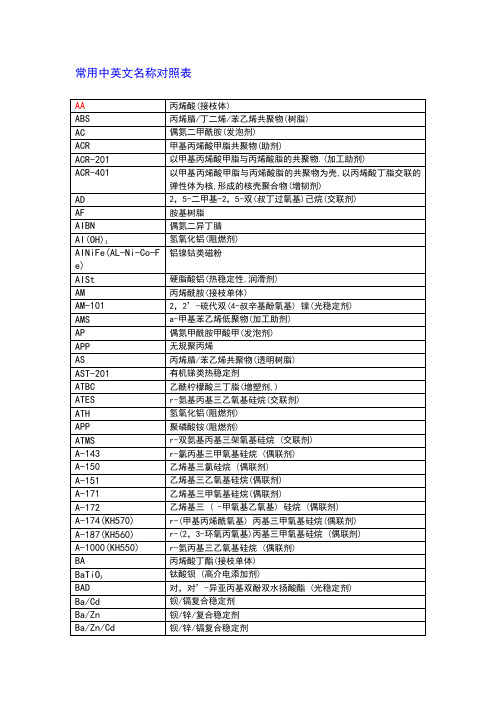
抗氧剂H
N,N"-二芳基对苯二胺(抗氧剂)
促进剂H
六次甲基四胺(固化剂)
HALS
受阻胺类(稳定剂)
HBCD
六溴环十二烷(阻燃剂)
HCFCs
氢氯氟烃烷(发泡剂)
HCFC-22
CHCIF2(发泡剂)
HCFC-123
ChCl2CF3(发泡剂)
HCFC-1411
CCl2FCH3(发泡剂)
高分子量聚氯乙烯(树脂)
HRA
苯乙烯/丙烯腈/N-苯基马来酰亚胺三元共聚物(PVC耐热添加剂)
HSt(SA)
硬脂酸(润滑剂)
IBR(PIB)
聚异丁烯(树脂)
IFR
膨胀型阻燃剂
IIR
丁基橡胶
IPN
互穿网络聚合物
K
苯乙烯/丁二烯(75/25)共聚物
KH550
同A-1000
KH560
同A-187
KH570
r-(2,3-环氧丙氧基)丙基三甲氧基硅烷 (偶联剂)
A-1000(KH550)
r-氨丙基三乙氧基硅烷 (偶联剂)
BA
丙烯酸丁酯(接枝单体)
BaTiO3
钛酸钡 (高介电添加剂)
BAD
对,对’-异亚丙基双酚双水扬酸酯 (光稳定剂)
Ba/Cd
钡/镉复合稳定剂
Ba/Zn
钡/锌/复合稳定剂
Ba/Zn/Cd
钡/锌/镉复合稳定剂
季铵盐型钛酸酯偶联剂
KR-262M
同KR-238M
抗氧剂KY-7910
同抗氧剂1010
抗氧剂KY-7920
抗氧剂1076
LS
有机二元酸与ⅡA族金属的氧化物、氢氧化物及基盐共混物(β晶型成核剂)
塑料原料名称(中英文对照)

塑料类别
俗称
中文学名
英文学名
英文简称
主要用途
热
聚苯乙烯类
硬胶
通用聚苯乙烯
General Purpose Polystyrene
PS
灯罩、仪器壳罩、玩具等
不脆胶
高冲击聚苯乙烯
High Impact Polystyrene
HIPS
日用品、电器零件、玩具等
塑
改性聚苯乙烯类
ABS料
丙烯腈-丁二烯-苯乙烯
POM
耐磨性好,可以作机械的齿轮,轴承等
纤维素类
赛璐璐
硝酸纤维素
Cellulose Nitrate
CN
眼镜架,玩具等
酸性胶
醋酸纤维素
Cellulose Acetate
CA
家用器具,工具手柄,容器等
乙基纤维素
Ethyl Cellulose
EC
工具手柄,体育用品等
饱和聚脂
涤纶(的确凉)
聚对苯二甲酸乙二醇脂
料
不饱和聚脂
醇酸树脂
Alkyd Resin
AK
涂料,玻璃钢,装饰件,地板,钮扣等
烯丙基树脂
AllylResin
DAP
Poly(EthyleneTerephthalare)
PET
轴承,链条,齿轮,录音带等
聚对苯二甲酸丁二醇脂
Poly(ButyleneTerephthalare)
PBT
聚氯乙烯类
PVC
聚氯乙烯
Poly(Vinyl Chloride)
PVC
制造棒,管,板材,输油管,电线绝缘层,密封件等
氟塑料类PVF
F4氟料
降解塑料英文作文

降解塑料英文作文英文:As we all know, plastic pollution has become a serious problem in our world. One solution to this problem is to degrade plastic. There are two main ways to degrade plastic: physical and chemical.Physical degradation involves breaking down the plastic into smaller pieces through mechanical processes such as grinding or shredding. This method is often used to recycle plastic, as the smaller pieces can be melted down andreused to make new products.Chemical degradation, on the other hand, involves breaking down the plastic using chemical reactions. This method can be further divided into two types:biodegradation and photodegradation. Biodegradationinvolves using microorganisms to break down the plastic, while photodegradation involves using sunlight to breakdown the plastic.Biodegradation is a promising method for degrading plastic, as it is a natural process that does not produce harmful byproducts. For example, researchers have discovered a type of bacteria that can break down polyethylene, a common plastic, into harmless substances. This bacteria can be used to degrade plastic in landfills and other environments where plastic waste accumulates.Photodegradation is another method that shows promise. When plastic is exposed to sunlight, it breaks down into smaller pieces that can be degraded further by microorganisms. However, this method has some drawbacks, as it requires a lot of sunlight and can release harmful chemicals into the environment.In conclusion, degradation is a promising solution to the problem of plastic pollution. By breaking down plastic into harmless substances, we can reduce the amount of plastic waste in our environment and protect our planet for future generations.中文:众所周知,塑料污染已成为我们世界面临的一个严重问题。
塑料中英文对照
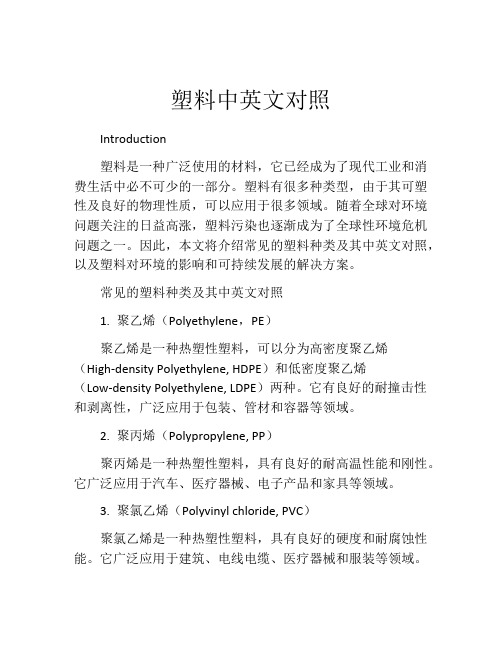
塑料中英文对照Introduction塑料是一种广泛使用的材料,它已经成为了现代工业和消费生活中必不可少的一部分。
塑料有很多种类型,由于其可塑性及良好的物理性质,可以应用于很多领域。
随着全球对环境问题关注的日益高涨,塑料污染也逐渐成为了全球性环境危机问题之一。
因此,本文将介绍常见的塑料种类及其中英文对照,以及塑料对环境的影响和可持续发展的解决方案。
常见的塑料种类及其中英文对照1. 聚乙烯(Polyethylene,PE)聚乙烯是一种热塑性塑料,可以分为高密度聚乙烯(High-density Polyethylene, HDPE)和低密度聚乙烯(Low-density Polyethylene, LDPE)两种。
它有良好的耐撞击性和剥离性,广泛应用于包装、管材和容器等领域。
2. 聚丙烯(Polypropylene, PP)聚丙烯是一种热塑性塑料,具有良好的耐高温性能和刚性。
它广泛应用于汽车、医疗器械、电子产品和家具等领域。
3. 聚氯乙烯(Polyvinyl chloride, PVC)聚氯乙烯是一种热塑性塑料,具有良好的硬度和耐腐蚀性能。
它广泛应用于建筑、电线电缆、医疗器械和服装等领域。
4. 聚苯乙烯(Polystyrene, PS)聚苯乙烯是一种热塑性塑料,具有良好的透明度和韧性。
它广泛应用于电子产品、饮料杯和包装等领域。
5. 聚碳酸酯(Polycarbonate, PC)聚碳酸酯是一种热塑性塑料,具有良好的耐高温性能和透明度。
它广泛应用于汽车、电子产品和建筑等领域。
6. 聚乳酸(Polylactic acid, PLA)聚乳酸是一种生物可降解的塑料,由植物淀粉制成。
它可以降解为二氧化碳和水,对环境比较友好。
它广泛应用于食品包装、医疗器械和支架等领域。
塑料对环境的影响和可持续发展的解决方案塑料的大量生产和使用给环境带来了严重的问题。
首先,塑料制品通常需要长时间才能自然降解,因此会在自然环境中持续存在,对地球生态系统和野生动植物造成影响;其次,塑料制品的生产需要消耗大量的能源和原材料,加剧了资源短缺问题;最后,塑料制品的废弃物需要大量处理,占据大量的垃圾填埋场和废弃物处理中心。
(完整版)塑料简称中英文对照汇总
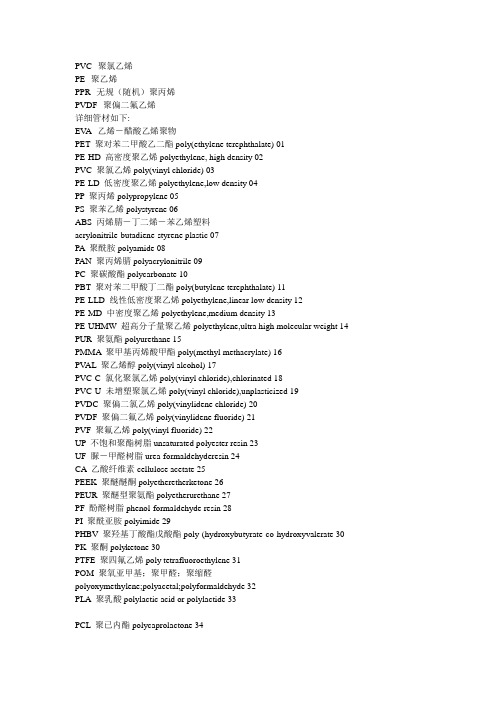
PVC--聚氯乙烯PE--聚乙烯PPR--无规(随机)聚丙烯PVDF--聚偏二氟乙烯详细管材如下:EV A--乙烯-醋酸乙烯聚物PET 聚对苯二甲酸乙二酯poly(ethylene terephthalate) 01PE-HD 高密度聚乙烯polyethylene, high density 02PVC 聚氯乙烯poly(vinyl chloride) 03PE-LD 低密度聚乙烯polyethylene,low density 04PP 聚丙烯polypropylene 05PS 聚苯乙烯polystyrene 06ABS 丙烯腈-丁二烯-苯乙烯塑料acrylonitrile-butadiene-styrene plastic 07PA 聚酰胺polyamide 08PAN 聚丙烯腈polyacrylonitrile 09PC 聚碳酸酯polycarbonate 10PBT 聚对苯二甲酸丁二酯poly(butylene terephthalate) 11PE-LLD 线性低密度聚乙烯polyethylene,linear low density 12PE-MD 中密度聚乙烯polyethylene,medium density 13PE-UHMW 超高分子量聚乙烯polyethylene,ultra high molecular weight 14 PUR 聚氨酯polyurethane 15PMMA 聚甲基丙烯酸甲酯poly(methyl methacrylate) 16PV AL 聚乙烯醇poly(vinyl alcohol) 17PVC-C 氯化聚氯乙烯poly(vinyl chloride),chlorinated 18PVC-U 未增塑聚氯乙烯poly(vinyl chloride),unplasticized 19PVDC 聚偏二氯乙烯poly(vinylidene chloride) 20PVDF 聚偏二氟乙烯poly(vinylidene fluoride) 21PVF 聚氟乙烯poly(vinyl fluoride) 22UP 不饱和聚酯树脂unsaturated polyester resin 23UF 脲-甲醛树脂urea-formaldehyderesin 24CA 乙酸纤维素cellulose acetate 25PEEK 聚醚醚酮polyetheretherketone 26PEUR 聚醚型聚氨酯polyetherurethane 27PF 酚醛树脂phenol-formaldehyde resin 28PI 聚酰亚胺polyimide 29PHBV 聚羟基丁酸酯戊酸酯poly-(hydroxybutyrate-co-hydroxyvalerate 30 PK 聚酮polyketone 30PTFE 聚四氟乙烯poly tetrafluoroethylene 31POM 聚氧亚甲基;聚甲醛;聚缩醛polyoxymethylene;polyacetal;polyformaldehyde 32PLA 聚乳酸polylactic acid or polylactide 33PCL 聚已内酯polycaprolactone 34PPDO 聚对二氧环己酮35PPC 二氧化碳共聚合物carbon dioxide copolymer 36PBS 聚丁二酸丁二醇酯Polybuthylenesuccinate 37PHA 聚羟基脂肪酸酯polyhydroxyalkanoic or polyhydroxyalkanoates 38 PHB 聚-3-羟基丁酸polyhydroxybutyric acid or polyhydroxybutyrate 39 PGA 聚乙交酯poly(glycolic acid) 40PEC PolyEster Carbonate or Poly(Butylene Succinate/Carbonate) 41PES Poly(Ethylene Succinate) 42PTMAT Poly(TetraMethylene Adipate/Terephthalate) 43PBA T Poly(Butylene Adipate/Terephthalate) 44AB 丙烯腈-丁二烯塑料acrylonitrile-butadiene plastic 45ABAK 丙烯腈-丁二烯-丙烯酸酯塑料acrylonitrile-butadiene-acrylate plastic 46ACS 丙烯腈-氯化聚乙烯-苯乙烯塑料acrylonitrile-chlorinated polyethylene-styrene 47AEPDS 丙烯腈-(乙烯-丙烯-二烯)-苯乙烯塑料acrylonitrile-(ethylene-propylene-diene)-styrene plastic 48AMMA 丙烯腈-甲基丙烯酸甲酯塑料acrylonitrile-methyl methacryate plastic 49ASA 丙烯腈-苯乙烯-丙烯酸酯塑料acrylonitrile-stytene-acrylate plastic 50CAB 乙酸丁酸纤维素cellulose acetate butyrate 51CAP 乙酸丙酸纤维素cellulose acetate propionate 52CEF 甲醛纤维素cellulose formaldehyde 53CF 甲酚-甲醛树脂cresol-formaldehyde resin 54CMC 羧甲基纤维素carboxymethyl cellulose 55CN 硝酸纤维素cellulose nitrate 56COC 环烯烃共聚物cycloolefin copolymer 57CP 丙酸纤维素cellulose propionate 58CTA 三乙酸纤维素cellulose triacetate 59E/P 乙烯-丙烯塑料ethylene-propylene plastic 60EAA 乙烯-丙烯酸塑料ethylene-acrylic acid plastic 61EBAK 乙烯-丙烯酸丁酯塑料ethylene-butyl acrylate plastic 62EC 乙基纤维素ethyl cellulose 63EEAK 乙烯-丙烯酸乙酯塑料ethylene-ethyl acrylate plastic 64EMA 乙烯-甲基丙烯酸塑料ethylene-methacrylic acid plastic 65EP 环氧;环氧树脂或塑料epoxide;epoxy resin or plastic 66ETFE 乙烯-四氟乙烯塑料e thylene-tetrafluoroethylene plastic 67EV AC 乙烯-乙酸乙烯酯塑料ethylene-vinyl acetate plastic 68EVOH 乙烯-乙烯醇塑料ethylene-vinyl alcohol plastic 69FEP 全氟(乙烯-丙烯)塑料perfluoro(ethylene-propylene)plastic 70 FF 呋喃-甲醛树脂furan-formaldehyde resin 71LCP 液晶聚合物liquid-crystal polymer 72MABS 甲基丙烯酸甲酯-丙烯腈-丁二烯-苯乙烯塑料methyl methacrylate-acrylonitrile-butadiene-styrene plastic 73MBS 甲基丙烯酸甲酯-丁二烯-苯乙烯塑料methyl methacrylate-butadiene-styrene plastic 74MC 甲基纤维素methyl cellulose 75MF 三聚氰胺-甲醛树脂melamine-formaldehyde resin 76MP 三聚氰胺-酚醛树脂melamine-phenol resin 77MSAN α-甲基苯乙烯-丙烯腈塑料α-methylstyrene-acrylonitrile plastic 78PAA 聚丙烯酸poly(acrylic acid) 79PAEK 聚芳醚酮polyaryletherketone 80PAI 聚酰胺(酰)亚胺polyamidimide 81PAK 聚丙烯酸酯polyarylate 82PAR 聚芳酯polyarylate 83PARA 聚芳酰胺poly(aryl amide) 84PB 聚丁烯polybutene 85PBAK 聚丙烯酸丁酯poly(butyl acrylate) 86PBD 1,2-聚丁二烯1,2-polybutadiene 87PBN 聚萘二甲酸丁二酯poly(butylene naphthalate) 88PCCE 亚环己基-二亚甲基-环已基二羧酸酯poly(cyclohexylene dimethylene cyclohexanedicar- boxylate) 89PCT 聚(对苯二甲酸亚环已基-二亚甲酯)poly(cyclohexylene dimethylene terephthalate) 90PCTFE 聚三氟氯乙烯polychlorotrifluoroethylene 91PDAP 聚邻苯二甲酸二烯丙酯poly(diallyl phthalate) 92PDCPD 聚二环戊二烯polydicyclopentadiene 93PEC 聚酯碳酸酯polyestercarbonate 94PE-C 氯化聚乙烯polyethylene,chlorinated 95PEEST 聚醚酯polyetherester 96PEI 聚醚(酰)亚胺polyetherimide 97PEK 聚醚酮polyetherketone 98PEN 聚萘二甲酸乙二酯poly(ethylene naphthalate) 99PEOX 聚氧化乙烯poly(ethylene oxide) 100PESTUR 聚酯型聚氨酯polyesterurethane 101PESU 聚醚砜polyethersulfone 102PE-VLD 极低密度聚乙烯polyethylene,very low density 103PFA 全氟烷氧基烷树脂perfluoro alkoxyl alkane resin 104PIB 聚异丁烯polyisobutylene 105PIR 聚异氰脲酸酯polyisocyanurate 106PMI 聚甲基丙烯酰亚胺polymethacrylimide 107PMMI 聚N-甲基甲基丙烯酰亚胺poly-N-methylmethacrylimide 108 PMP 聚-4-甲基戊烯-1poly-4-methylpentene-1 109PMS 聚-α-甲基苯乙烯poly-α-methylstyrene 110PPE 聚苯醚poly(phenylene ether) 111PP-E 可发性聚丙烯polypropylene,expandable 112PP-HI 高抗冲聚丙烯polypropylene,high impact 113PPOX 聚氧化丙烯poly(propylene oxide) 114PPS 聚苯硫醚poly(phenylene sulfide) 115PPSU 聚苯砜poly(phenylene sulfone) 116PS-E 可发聚苯乙烯polystyrene,expandable 117PS-HI 高抗冲聚苯乙烯polystyrene,high impact 118PSU 聚砜polysulfone 119PTT 聚对苯二甲酸丙二酯poly(trimethylene terephthalate) 120PV AC 聚乙酸乙烯酯poly(vinyl acetate) 121PVB 聚乙烯醇缩丁醛poly(vinyl butyral) 122PVFM 聚乙烯醇缩甲醛poly(vinyl formal) 123PVK 聚-N-乙烯基咔唑poly-N-vinylcarbazole 124PVP 聚-N-乙烯基吡咯烷酮poly-N-vinylpyrrolidone 125SAN 苯乙烯一丙烯腈塑料styrene-acrylonitrile plastic 126SB 苯乙烯-丁二烯塑料styrene-butadiene plastic 127SI 有机硅塑料silicone plastic 128SMAH 苯乙烯-顺丁烯二酸酐塑料styrene-maleic anhydride plastic 129SMS 苯乙烯-α-甲基苯乙烯塑料styrene-α-methylstyrene plastic 130VCE 氯乙烯-乙烯塑料vinyl chloride-ethylene plastic 131VCEMAK 氯乙烯-乙烯-丙烯酸甲酯塑料vinyl chloride-ethylene-methyl acrylate plastic 132VCEV AC 氯乙烯-乙烯-丙烯酸乙酯塑料vinyl chloride-ethylene-vinyl acrylate plastic 133VCMAK 氯乙烯-丙烯酸甲酯塑料vinyl chloride-methyl acrylate plastic 134 VCMMA 氯乙烯-甲基丙烯酸甲酯塑料vinyl chloride-methyl methacrylate plastic 135VCOAK 氯乙烯-丙烯酸辛酯塑料vinyl chloride-octyl acrylate plastic 136 VCV AC 氯乙烯-乙酸乙烯酯塑料vinyl chloride-vinyl acetate plastic 137 VCVDC 氯乙烯-偏二氯乙烯塑料vinylchloride-vinylidene chloride plastic 138 VE 乙烯基酯树脂vinyl ester resin 139PE 聚乙烯polyethylene聚乙烯——PE聚丙烯——PP聚丁烯——PB聚氯乙稀——PVC耐热聚乙稀——PE-RT硬聚氯乙稀(增强聚氯乙烯)——PVC-U(UPVC)高密度聚乙烯——HDPE无规共聚聚丙烯——PP-R玻纤增强聚丙烯——FRPP低密度聚乙烯——LDPE聚甲基丙烯酸甲酯——PMMA聚四氟乙烯——PTFE(F4)三元乙丙橡胶——EPDM多孔聚苯乙烯——XPS腈基丁二烯橡胶(丁腈橡胶)——NBR耐冲击性聚苯乙烯——HIP聚氟乙烯——PVF纳米复合三型聚丙烯——NFPP-R塑料光纤——POF丙稀腈-丁二烯-苯乙烯——ABS氯化聚醚——CPS氯化聚醚丁腈(粉末丁腈橡胶)——PNBR 聚全氟乙丙稀(氟化乙丙稀)——FEP均聚聚丙烯——PPH聚偏氟乙烯——PVDF共聚酰胺(尼龙)——PA增强聚丙烯——RPP共聚酯——PES高分子聚丙烯酰胺——PAM增强氯化聚氯乙稀——CPVC嵌段共聚聚丙烯——PPB聚苯乙烯——PS交联聚乙烯——PEX聚烯烃——PO三氟氯乙烯——CTFE全氟代甲基醚——PMVE全氟代乙基醚——PEVE全氟代丙基醚——PPVE全氟代辛基醚——POVE全氟代烷氧基——PFA聚对苯二甲酸乙二醇酯——PET定向聚丙烯——OPP流延聚丙烯——CPP共聚甲醛(聚氧甲烯、缩醛)——POM茂金属线型低密度聚乙烯——MLLDPE丙烯酸酯橡胶——ACM氯丁胶——CR氟橡胶——FPM端缩基丁腈液体橡胶——HTBN硅胶——MQ氯磺化聚乙烯橡胶——CSM丁钠橡胶——S-BR天然橡胶——NR。
TOROWHITE FIL 04 生物降解塑料添加剂说明书

PRODUCT DATA SHEET TOROWHITE FIL 04 as a functional additive increases the thermal and mechanical properties of the biopolymer matrix in conjunction with other additives while decreasing the costs substantially.In biodegradable plastics such as polylactide (PLA) optimum results with improved functionalities are obtained at 20-40% FIL 04 levels in the respective composites.In highly filled PLA composites containing 40% of FIL 04, the co-addition of up to 10% impact modifier can significantly improve impact properties, leading to 2-3 times increase in impact strength.TOROWHITE FIL 04 can also be used to significantly improve the flame retardant property of polylactide (PLA) based polymers utilized in conjunction with other additives.PLA composites containing FIL 04 with other as flame retardant without halogens are classified “VO” ( in the case of 25% FIL 04) and “V2“ (in the case of 40% FIL 04).*FIL 04 displays excellent dispersion properties in compounds with PLA based polymers.BIOPOLYMERS AND COMPOSITES FOR DURABLE APPLICATIONSTOROWHITE FIL 04 is a Calcium Sulfate Anhydrite (AII) functional additive with very high purity & good whiteness. FIL 04 is produced from specially selected Food & Pharma Grade natural gypsum. N arrow particle size distribution enables high performance in terms of thermal and mechanical characteristics, dimensional stability, optical properties and processability. Made by controlled dehydration of Calcium Sulfate Dihydrate at high temperature it is known as «insoluble» Anhydrite II due to its very low absorbtion of water.HIGHLIGHTS• Ideal filler for food packaging with resistance to acidic foods • Prevents migration acting as a functional filler • Produced from food & pharma grade natural gypsum • High Purity > 98% CaSO 4• Good whiteness • Improved UV resistance • Good impact properties • Easy to process due to low Mohs hardness • High thermal stability • Good tensile strength and flexural strength • Significant cost reduction for the polymer matrix •Optimized for production and improvement of functionalities of PLA and other biopolymers • Odourless • Does not conduct electricityFIELDS OF APPLICATION: Automotive, engineering appliances, packaging, paints, biomedical, paper, special additives and adhesives, materials, rigid PVC, others.FIL 04POLYMER & BIOPOLYMER FUNCTIONAL ADDITIVE CALCIUM SULFATE ANHYDRITE *Source: Materia Nova R&D CenterPRODUCT DATA SHEETTECHNICAL DATAPhysical propertiesFood & Pharma Grade raw material with the following results for FIL 04Typical Chemical Analysis(1) According to the standard ASTM B527(2) Quantachrome Ultrapyc-1200e (3) Literature data (R. Rothon, Fillers for Polymer Applications, Springer 2017)(4) Datacolor ELREPHO (5) Malvern Mastersizer 3000(6) ASTM D1483(7) Quantachrome NOVAtouch Tap Density (g/cm 3) (1)0.9Pycnometer Density (g/cm 3) (2)2.8 -3.0Mohs hardness (3)2.0 -3.0Refractive index (3)1.55 - 1.60Whiteness (CIE L value) (4)L* > 93Medium particle size D50 (microns) (5)3.80 -4.70Maximum particle size D98 (microns)16 - 20Oil Absorption-DOP (g/100g) (6)26.76BET Surface Area (m2/g) (7)8.76pH (10% slurry)10.0 – 11.0Purity> 98% CaSO 4Crystal shapeorthorhombic Water content max. 1.0% (TGA method)Assay>99%Flame TestRed Flame Calcium present Sulphate TestPresent Solubility in WaterSlightly Soluble Solubility in EthanolInsoluble Fluoride (Anion IC)<30.0 mg/kg Selenium (F5202)<10.0 mg/kg Arsenic (F5202)< 1.0 mg/kg Lead (F5202)< 1.0 mg/kg Mercury (F5202)< 0.5 mg/kg Chemical nameCalcium Sulfate Anhydrite Molecular formulaCaSO 4CAS number 7778-18-9This information is given to the best of our knowledge. Although all statements and results shown in this document are believed to be accurate and reliable, they are presented for guidance and as information only. Because of the multitude of formulations and processing conditions, the above-mentioned statements must be adapted by user to the requirements of application.。
最全的塑料产品中英文对照
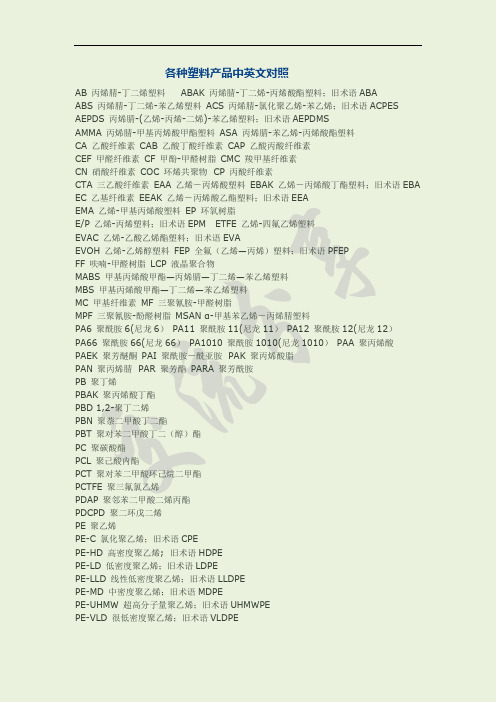
各种塑料产品中英文对照AB 丙烯腈-丁二烯塑料 ABAK 丙烯腈-丁二烯-丙烯酸酯塑料;旧术语ABAABS 丙烯腈-丁二烯-苯乙烯塑料ACS 丙烯腈-氯化聚乙烯-苯乙烯;旧术语ACPES AEPDS 丙烯腈-(乙烯-丙烯-二烯)-苯乙烯塑料;旧术语AEPDMSAMMA 丙烯腈-甲基丙烯酸甲酯塑料ASA 丙烯腈-苯乙烯-丙烯酸酯塑料CA 乙酸纤维素CAB 乙酸丁酸纤维素CAP 乙酸丙酸纤维素CEF 甲醛纤维素CF 甲酚-甲醛树脂CMC 羧甲基纤维素CN 硝酸纤维素COC 环烯共聚物 CP 丙酸纤维素CTA 三乙酸纤维素EAA 乙烯-丙烯酸塑料EBAK 乙烯-丙烯酸丁酯塑料;旧术语EBA EC 乙基纤维素EEAK 乙烯-丙烯酸乙酯塑料;旧术语EEAEMA 乙烯-甲基丙烯酸塑料EP 环氧树脂E/P 乙烯-丙烯塑料;旧术语EPM ETFE 乙烯-四氟乙烯塑料EVAC 乙烯-乙酸乙烯酯塑料;旧术语EVAEVOH 乙烯-乙烯醇塑料FEP 全氟(乙烯—丙烯)塑料;旧术语PFEPFF 呋喃-甲醛树脂LCP 液晶聚合物MABS 甲基丙烯酸甲酯—丙烯腈—丁二烯—苯乙烯塑料MBS 甲基丙烯酸甲酯—丁二烯—苯乙烯塑料MC 甲基纤维素MF 三聚氰胺-甲醛树脂MPF 三聚氰胺-酚醛树脂MSAN α-甲基苯乙烯-丙烯腈塑料PA6 聚酰胺6(尼龙6)PA11 聚酰胺11(尼龙11)PA12 聚酰胺12(尼龙12)PA66 聚酰胺66(尼龙66)PA1010 聚酰胺1010(尼龙1010)PAA 聚丙烯酸PAEK 聚芳醚酮PAI 聚酰胺-酰亚胺 PAK 聚丙烯酸脂PAN 聚丙烯腈 PAR 聚芳酯PARA 聚芳酰胺PB 聚丁烯PBAK 聚丙烯酸丁酯PBD 1,2-聚丁二烯PBN 聚萘二甲酸丁二酯PBT 聚对苯二甲酸丁二(醇)酯PC 聚碳酸酯PCL 聚己酸内酯PCT 聚对苯二甲酸环己烷二甲酯PCTFE 聚三氟氯乙烯PDAP 聚邻苯二甲酸二烯丙酯PDCPD 聚二环戊二烯PE 聚乙烯PE-C 氯化聚乙烯;旧术语CPEPE-HD 高密度聚乙烯; 旧术语HDPEPE-LD 低密度聚乙烯;旧术语LDPEPE-LLD 线性低密度聚乙烯;旧术语LLDPEPE-MD 中密度聚乙烯;旧术语MDPEPE-UHMW 超高分子量聚乙烯;旧术语UHMWPEPE-VLD 很低密度聚乙烯;旧术语VLDPEPEC 聚酯碳酸酯PEEK 聚醚醚酮PEEST 聚醚型聚酯PEI 聚醚酰亚胺PEK 聚醚酮PEN 聚萘二甲酸乙二酯PEOX 聚环氧乙烷PESTUR 聚酯型聚氨酯PES 聚醚砜PET 聚对苯二甲酸乙二(醇)酯PEUR 聚醚型聚氨酯PF 酚醛树脂PFA 全氟烷氧基烷烃聚合物PI 聚酰亚胺PIB 聚异丁烯PIR 聚异氰酸酯PK 聚酮PMI 聚甲基丙烯酰亚胺PMMA 聚甲基丙烯酸甲酯PMMI 聚(N-甲基甲基丙烯酰亚胺)PMP 聚(4-甲基-1-戊烯)PMS 聚(α-甲基苯乙烯)POM 聚甲醛PP 聚丙烯PP-E 可发型聚丙烯;旧术语EPPPP-HI 高抗冲聚丙烯;旧术语HIPPPPE 聚苯醚PPOX 聚(氧化丙烯) , 聚环氧丙烷PPS 聚苯硫醚PPSU 聚苯砜PS 聚苯乙烯PS-E 可发性聚苯乙烯;旧术语EPSPS-HI 高抗冲聚苯乙烯;旧术语HIPS PSU 聚砜PTFE 聚四氟乙烯PTT 聚对苯二甲酸亚丙基酯PUR 聚氨脂PVAC 聚乙酸乙烯酯PVAL 聚乙烯醇;旧术语PVOHPVB 聚乙烯醇缩丁醛PVC 聚氯乙烯PVC-C 氯化聚氯乙烯;旧术语CPVC PVC-U 未增塑的聚氯乙烯;旧术语UPVCPVDC 聚偏(二)氯乙烯PVDF 聚偏(二)氟乙烯PVF 聚氟乙烯PVFM 聚乙烯醇缩甲醛PVK 聚-N-乙烯基咔唑PVP 聚-N-乙烯基吡咯烷酮SAN 苯乙烯-丙烯腈塑料SB 苯乙烯-丁二烯塑料SI (聚)硅氧烷塑料SMAH 苯乙烯-顺丁烯二酸酐塑料;旧述语S/MA或SMASMS 苯乙烯-α-甲基苯乙烯塑料UF 脲醛树脂UP 不饱和聚酯树脂VCE 氯乙烯-乙烯塑料VCEMAK 氯乙烯-乙烯-丙烯酸甲酯塑料;旧术语VCEMAVCEVAC 氯乙烯-乙烯-乙酸乙烯酯塑料VCMAK; 氯乙烯-丙烯酸甲酯塑料;旧术语VCMAVCMMA 氯乙烯-甲基丙烯酸甲酯塑料;VCOAK 氯乙烯-丙烯酸辛酯塑料; 旧术语VCOAVCVAC 氯乙烯-乙酸乙烯酯塑料VCVDC 氯乙烯-偏二氯乙烯塑料VE 乙烯基酯树脂ABR 丙烯酸酯一丁二烯橡胶ACM 丙烯酸乙酯(或其它的丙烯酸酯)和少量易硫化的单体的共聚物(通常称之为丙烯酸酯橡胶)AEM 丙烯酸乙酯(或其它的丙烯酸酯)和乙烯的共聚物AFMU 四氟乙烯,三氟亚硝基甲烷和亚硝基全氟丁酸的三元共聚物ANM 丙烯酸乙酯(或其它的丙烯酸酯)和丙烯腈的共聚物AU 聚酯型聚氨酯橡胶BIIR 溴化异丁烯-异丙烯橡胶(通常称之为溴化丁基橡胶)BR 聚丁二烯橡胶(通常称之为顺丁橡胶)CIIR 氯化异丁烯-异丙烯橡胶(通常称之为氯化丁基橡胶)CM 氯化聚乙烯CO 聚氯甲基环氧乙烷(通常称之为表氯醇橡胶)CSM 氯磺化聚乙烯CR 氯丁橡胶ECO 环氧乙烷和氯甲基环氧乙烷的共聚物(也称之为表氯醇橡胶)ENR 环氧化天然橡胶EPDM 乙烯,丙烯和二烯烃(其聚合过的侧链带有不饱键)的三元共聚物(通常称之为三元乙丙橡胶)EPM 乙烯-丙烯共聚物EU 聚醚型聚氨酯橡胶EVM 乙烯-乙酸乙烯酯共聚物FEPM 四氟乙烯和丙烯的共聚物FFKM 全氟橡胶(其聚合物链上的所有取代基全是氟原子,全氟烃基或全氟烷氧基)FKM 氟橡胶(聚合物链上有氟原子取代基,全氟烃基或全氟烷氧基)FMQ 聚合物链上有甲基和氟原子取代基的硅橡胶FVMQ 聚合物链上有甲基、乙烯基和氟原子取代基的硅橡胶GECO 环氧氯丙烷-环氧乙烷-烯丙基缩水甘油醚的三元共聚物GPO 环氧丙烷和烯丙基缩水甘油醚的共聚物HNBR 氢化丁腈橡胶IIR 异丁烯-异戊二烯橡胶(通常称之为丁基橡胶)IR 异戊二烯橡胶(合成橡胶)IM 聚异丁烯橡胶MSBR α-甲基苯乙烯一丁二烯橡胶MQ 聚合物链上只有甲基取代基的硅橡胶,如二甲基聚硅氧烷NBM 全氢化丙烯腈一丁二烯共聚物NBR 丁腈橡胶NIR 丙烯腈-异戊二烯橡胶NR 异戊二烯橡胶(天然橡胶)PBR 乙烯基吡啶-丁二烯橡胶PMQ 聚合物链上带有甲基和苯基取代基的的硅橡胶PSBR 乙烯基吡啶-苯乙烯-丁二烯橡胶PVMQ 聚合物链上带有甲基、乙烯基和苯基取代基的硅橡胶SBR 丁苯橡胶E-SBR 乳液聚合的丁苯橡胶S-SBR 溶液聚合的丁苯橡胶SIBR 苯乙烯-异戊二烯-丁二烯橡胶VMQ 聚合物链上带有甲基和乙烯基取代基的硅橡胶XBR 羧基丁二烯橡胶XCR 羧基氯丁橡胶XNBR 羧基丁腈橡胶XSBR 羧基丁苯橡胶FCEA TPV 完全交联的弹性体合金HCTPV TPV 高交联的热塑性硫化橡胶TPV-(EPDM+PP)三元乙丙橡胶和聚丙烯的共混物,其中三元乙丙橡胶相高度交联并均匀分散于连续的聚丙烯相中。
浅析生物可降解高分子材料的开发利用中英文对照
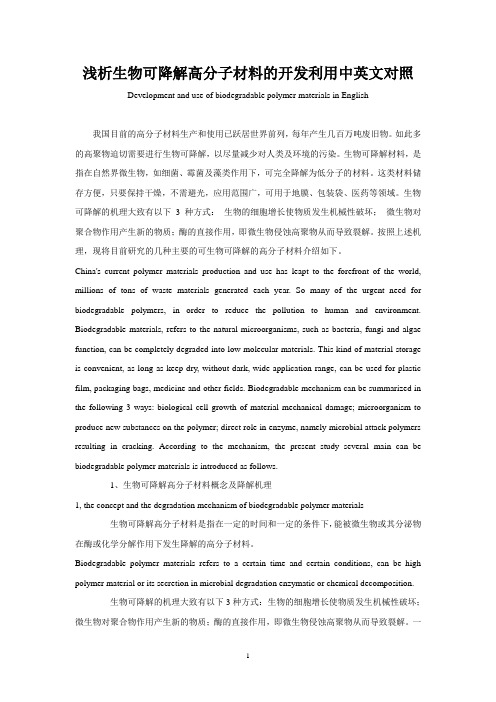
浅析生物可降解高分子材料的开发利用中英文对照Development and use of biodegradable polymer materials in English我国目前的高分子材料生产和使用已跃居世界前列,每年产生几百万吨废旧物。
如此多的高聚物迫切需要进行生物可降解,以尽量减少对人类及环境的污染。
生物可降解材料,是指在自然界微生物,如细菌、霉菌及藻类作用下,可完全降解为低分子的材料。
这类材料储存方便,只要保持干燥,不需避光,应用范围广,可用于地膜、包装袋、医药等领域。
生物可降解的机理大致有以下3 种方式:生物的细胞增长使物质发生机械性破坏;微生物对聚合物作用产生新的物质;酶的直接作用,即微生物侵蚀高聚物从而导致裂解。
按照上述机理,现将目前研究的几种主要的可生物可降解的高分子材料介绍如下。
China's current polymer materials production and use has leapt to the forefront of the world, millions of tons of waste materials generated each year. So many of the urgent need for biodegradable polymers, in order to reduce the pollution to human and environment. Biodegradable materials, refers to the natural microorganisms, such as bacteria, fungi and algae function, can be completely degraded into low molecular materials. This kind of material storage is convenient, as long as keep dry, without dark, wide application range, can be used for plastic film, packaging bags, medicine and other fields. Biodegradable mechanism can be summarized in the following 3 ways: biological cell growth of material mechanical damage; microorganism to produce new substances on the polymer; direct role in enzyme, namely microbial attack polymers resulting in cracking. According to the mechanism, the present study several main can be biodegradable polymer materials is introduced as follows.1、生物可降解高分子材料概念及降解机理1, the concept and the degradation mechanism of biodegradable polymer materials生物可降解高分子材料是指在一定的时间和一定的条件下,能被微生物或其分泌物在酶或化学分解作用下发生降解的高分子材料。
OBE生物酶降解塑料母粒
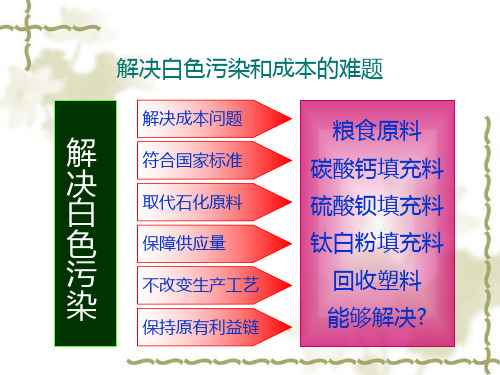
❖ 国内对于生物降解塑料的标准虽已制定,但法令的执行以及政策的支持尚未明朗, OBE产品的性价比对于环保塑料的使用以及法令规范起到了重要的示范效益,透过销 售量的高度成长,确保使用者、代理商、巨绿、资源永续利用、环境持续发展,法令 政策势必全力支持,促成五方共赢的局面。
加
紫
量
外
线
测
试
后
,
样
品
非
常
容
易
破
碎
LDPE75%
OBE
25%
黄变测试英文版
4级
添 加 量
1级最差 5级最好
LDPE75%
生物酶降解检测报告
❖ 符合国家环保总部 HJ/T209-2005环境标志技术要求,包 装制品。
❖ 依据标准GB/T19277-2003(IDT ISO 14855:1999) ❖ 北京国家塑料制品质量监督检验中心认证,国塑检
❖ 巨绿结合国内外代理商的销售渠道,迅速拓展OBE产品的市场,快速建立经济效益, 创造环保及获利的巨大事业。
品牌介绍
❖ 2012年尚昆集团总裁 ❖ 谷尚昆先生Mr.Gu Sang Kun ❖ 及其研发团队 ❖ 成功攻克-矿石生物酶 ❖ Ore BIO Enzyme ❖ 塑料母粒的生产技术 ❖ 并提出专利申请,定名为 ❖ OBE生物酶降解塑料母粒
11600
15750
無法添加
9000
10370
最終降解 降解環境 最终零污染 重复使用性 防潮防霉 物性满足 價格穩定度
塑料中英文对照
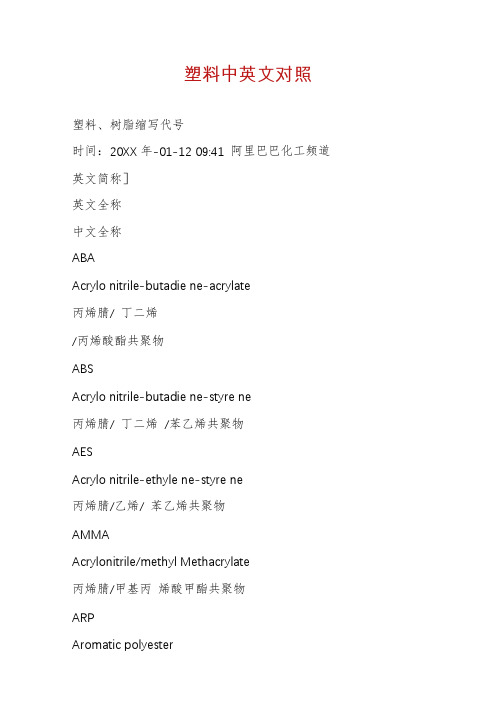
塑料中英文对照塑料、树脂缩写代号时间:20XX年-01-12 09:41 阿里巴巴化工频道英文简称]英文全称中文全称ABAAcrylo nitrile-butadie ne-acrylate丙烯腈/ 丁二烯/丙烯酸酯共聚物ABSAcrylo nitrile-butadie ne-styre ne丙烯腈/ 丁二烯/苯乙烯共聚物AESAcrylo nitrile-ethyle ne-styre ne丙烯腈/乙烯/ 苯乙烯共聚物AMMAAcrylonitrile/methyl Methacrylate丙烯腈/甲基丙烯酸甲酯共聚物ARPAromatic polyester聚芳香酯ASAcrylonitrile-styrene resin丙烯腈-苯乙烯树脂ASAAcry Ion itrile-styre ne-acrylate 丙烯腈/苯乙烯/丙烯酸酯共聚物CACellulose acetate醋酸纤维塑料CABCellulose acetate butyrate醋酸-丁酸纤维素塑料CAPCellulose acetate propi on ate 醋酸-丙酸纤维素CE“Cellulose plastics, gen eral"通用纤维素塑料CFCresol-formaldehyde甲酚-甲醛树脂CMCCarboxymethyl cellulose羧甲基纤维素CNCellulose n itrate硝酸纤维素CPCellulose propi on ate丙酸纤维素CPEChlori nated polyethyle ne氯化聚乙烯CPVCChlori nated poly (vinyl chloride) 氯化聚氯乙烯CSCasei n酪蛋白CTACellulose triacetate二醋酸纤维素ECEthyl cellulose乙烷纤维素EEAEthyle ne/ethyl acrylate乙烯/丙烯酸乙酯共聚物EMAEthyle ne/methacrylic acid乙烯/甲基丙烯酸共聚物EP"Epoxy, epoxide"环氧树脂EPDEthyle ne-propyle ne-die ne 乙烯-丙烯-二烯三元共聚物EPMEthyle ne-propyle ne polymer 乙烯-丙烯共聚物EPSExpa nded polystyre ne发泡聚苯乙烯ETFEEthyle ne-tetrafluoroethyle ne乙烯-四氟乙烯共聚物EVAEthylene/vinyl acetate乙烯-醋酸乙烯共聚物EVALEthyle ne-vinyl alcohol乙烯-乙烯醇共聚物FEPPerfluoro(ethyle ne-propyle ne)全氟(乙烯-丙烯)塑料FFFura n formaldehyde呋喃甲醛HDPEHigh-de nsity polyethyle ne plastics 咼密度聚乙烯塑料HIPSHigh impact polystyre ne咼冲聚苯乙烯IPSImpact-resista nt polystyre ne耐冲击聚苯乙烯LCPLiquid crystal polymer液晶聚合物LDPELow-density polyethylene plastics低密度聚乙烯塑料LLDPELin ear low-de nsity polyethyle ne线性低密聚乙烯LMDPELin ear medium-de nsity polyethyle ne 线性中密聚乙烯MBSMethacrylate-butadie ne-styre ne甲基丙烯酸-丁一烯-苯乙烯共聚物MCMethyl cellulose甲基纤维素MDPEMedium-de nsity polyethyle ne中密聚乙烯MFMelam in e-formaldehyde res in 密胺-甲醛树脂MPFMelami ne/phe nol-formaldehyde 密胺/酚醛树脂PAPolyamide (nylon)聚酰胺(尼龙)PAAPoly(acrylic acid)聚丙烯酸PADCPoly(allyl diglycol carb on ate)碳酸-二乙二醇酯?烯丙醇酯树脂PAEPolyarylether聚芳醚PAEK Polyaryletherket one 聚芳醚酮PAIPolyamide-imide聚酰胺-酰亚胺英文简称英文全称中文全称PAKPolyester alkyd聚酯树脂PANPolyacrylo ni trile聚丙烯腈PARAPolyaryl amide聚芳酰胺PASUPolyarylsulfo ne聚芳砜PATPolyarylate聚芳酯PAURPoly(ester uretha ne)聚酯型聚氨酯PBPolybute ne-1聚丁烯-PBAPoly(butyl acrylate)聚丙烯酸丁酯PBANPolybutadie ne-acrylo ni trile 聚丁二烯-丙烯腈PBSPolybutadie ne-styre ne聚丁二烯-苯乙烯PBTPoly(butyle ne terephthalate)聚对苯二酸丁二酯PCPolycarb on ate聚碳酸酯PCTFE Polychlorotrifluoroethyle ne聚氯三氟乙烯PDAPPoly(diallyl phthalate)聚对苯二甲酸二烯丙酯PEPolyethyle ne聚乙烯PEBAPolyether block amide聚醚嵌段酰胺PEBAThermoplastic elastomer polyether 聚酯热塑弹性体PEEKPolyetheretherket one聚醚醚酮PEIPoly(etherimide)聚醚酰亚胺PEKPolyether ket one聚醚酮PEOPoly(ethyle ne oxide)聚环氧乙烷PESPoly(ether sulfo ne)聚醚砜PETPoly(ethyle ne terephthalate)聚对苯二甲酸乙二酯PETGPoly(ethyle ne terephthalate) glycol 二醇类改性PETPEURPoly(ether uretha ne)聚醚型聚氨酯PFPhe nol-formaldehyde resi n 酚醛树脂PFAPerfluoro(alkoxy alka ne)全氟烷氧基树脂PFFPhenol-furfural resin酚呋喃树脂PIPolyimide聚酰亚胺PIBPolyisobutyle ne聚异丁烯PISUPolyimidesulfo ne聚酰亚胺砜PMCAPoly(methyl-alpha-chloroacrylate) 聚a -氯代丙烯酸甲酯PMMAPoly(methyl methacrylate)聚甲基丙烯酸甲酯PMPPoly(4-methylpe nten e-1)聚4-甲基戊烯-1PMSPoly(alpha-methylstyre ne)聚a -甲基苯乙烯POM"Polyoxymethyle ne, polyacetal" 聚甲醛PPPolypropyle ne聚丙烯PPAPolyphthalamide聚邻苯二甲酰胺PPEPoly(phe nylene ether)聚苯醚PPOPoly(phe nylene oxide) deprecated 聚苯醚PPOXPoly(propyle ne oxide)聚环氧(丙)烷PPSPoly(phe nylene sulfide)聚苯硫醚PPSUPoly(phe nylene sulfo ne)聚苯砜PSPolystyre ne聚苯乙烯PSUPolysulfo ne聚砜PTFEPolytetrafluoroethyle ne聚四氟乙烯PURPolyuretha ne聚氨酯PVACPoly(vinyl acetate)聚醋酸乙烯PVALPoly(vi nyl alcohol)聚乙烯醇英文简称「—英文全称中文全称PVBPoly(vinyl butyral)聚乙烯醇缩丁醛PVC ~Poly (vinyl chloride)聚氯乙烯PVCAPoly(vinyl chloride-acetate)聚氯乙烯醋酸乙烯酯PVCCchlori nated poly (vinyl chloride)(*CPVC) 氯化聚氯乙烯PVIpoly (vinyl isobutyl ether)聚(乙烯基异丁基醚)PVMpoly (vinylchloride vinyl methyl ether)聚(氯乙烯-甲基乙烯基醚)RAMrestricted area mold ing窄面模塑RFresorci nol-formaldehyde res in甲苯二酚-甲醛树脂RIM;react ion injectio n moldi ng反应注射模塑RPrein forced plastics增强塑料RRIMrein forced react ion inject ion moldi ng 增强反应注射模塑RTPrein forced thermoplastics增强热塑性塑料S/ANstyre ne-acry on itrile copolymer苯乙烯-丙烯腈共聚物SBSstyre ne-butadie ne block copolymer 苯乙烯-丁二烯嵌段共聚物SIsilic one聚硅氧烷SMCsheet mold ing compo und片状模塑料S/MSstyrene- a -methylstyrene copolymer 苯乙烯-a -甲基苯乙烯共聚物TMCthick moldi ng compo und厚片模塑料TPEthermoplastic elastomer热塑性弹性体TPStoughe ned polystyre ne韧性聚苯乙烯TPUthermoplastic uretha nes热塑性聚氨酯TPXploymethylpe ntene聚-4-甲基-1戊烯VG/Eviny Ichloride-ethyle ne copolymer聚乙烯-乙烯共聚物VC/E/MAvin ylchloride-ethyle ne-methylacrylate copolymer 聚乙烯-乙烯- 丙烯酸甲酯共聚物VC/E/VCAviny Ichloride-ethyle ne-viny lacetate copolymer 氯乙烯-乙烯- 醋酸乙烯酯共聚物PVDCPoly(vin ylide ne chloride)聚(偏二氯乙烯)PVDFPoly (vin ylide ne fluoride)聚(偏二氟乙烯)PVFPoly(vinyl fluoride)聚氟乙烯PVFMPoly(vinyl formal)聚乙烯醇缩甲醛PVKPolyviny Icarbazole聚乙烯咔唑PVPPol yviny Ipyrrolid one聚乙烯吡咯烷酮S/MAStyre ne-maleic an hydride plastic苯乙烯-马来酐塑料SANStyrene-acrylonitrile plastic苯乙烯-丙烯腈塑料SBStyre ne-butadie ne plastic苯乙烯-丁二烯塑料SiSilic one plastics有机硅塑料SMSStyre ne/alpha-methylstyre ne plastic 苯乙烯-a -甲基苯乙烯塑料SPSaturated polyester plastic饱和聚酯塑料SRPStyre ne-rubber plastics聚苯乙烯橡胶改性塑料TEEE"Thermoplastic Elastomer,Ether-Ester" 醚酯型热塑弹性体TEO"Thermoplastic Elastomer, Olefi ni c" 聚烯烃热塑弹性体TES"Thermoplastic Elastomer, Styre nic" 苯乙烯热塑性弹性体TPELThermoplastic elastomer热塑(性)弹性体TPESThermoplastic polyester热塑性聚酯TPURThermoplastic polyuretha ne热塑性聚氨酯TSURThermoset polyuretha ne热固聚氨酯「UFUrea-formaldehyde res in脲甲醛树脂UHMWPEUltra-high molecular weight PE超高分子量聚乙烯UPUn saturated polyester不饱和聚酯VCEVi nyl chloride-ethyle ne res in氯乙烯/乙烯树脂VCEVVinyl chloride-ethyle ne-vinyl氯乙烯/乙烯/醋酸乙烯共聚物VCMAVinyl chloride-methyl acrylate氯乙烯/丙烯酸甲酯共聚物VCMMAVinyl chloride-methylmethacrylate 氯乙烯/甲基丙烯酸甲酯共聚物VCOAVinyl chloride-octyl acrylate resin氯乙烯/丙烯酸辛酯树脂VCVACVinyl chloride-vinyl acetate res in 氯乙烯/醋酸乙烯树脂VCVDCVi nyl chloride-vin ylide ne chloride。
塑料降解英语
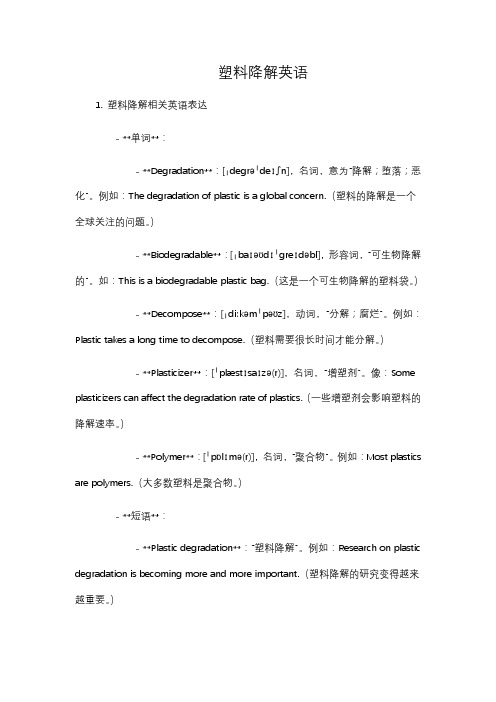
塑料降解英语1. 塑料降解相关英语表达- **单词**:- **Degradation**:[ˌdeɡrəˈdeɪʃn],名词,意为“降解;堕落;恶化”。
例如:The degradation of plastic is a global concern.(塑料的降解是一个全球关注的问题。
)- **Biodegradable**:[ˌbaɪəʊdɪˈɡreɪdəbl],形容词,“可生物降解的”。
如:This is a biodegradable plastic bag.(这是一个可生物降解的塑料袋。
)- **Decompose**:[ˌdiːkəmˈpəʊz],动词,“分解;腐烂”。
例如:Plastic takes a long time to decompose.(塑料需要很长时间才能分解。
)- **Plasticizer**:[ˈplæstɪsaɪzə(r)],名词,“增塑剂”。
像:Some plasticizers can affect the degradation rate of plastics.(一些增塑剂会影响塑料的降解速率。
)- **Polymer**:[ˈpɒlɪmə(r)],名词,“聚合物”。
例如:Most plastics are polymers.(大多数塑料是聚合物。
)- **短语**:- **Plastic degradation**:“塑料降解”。
例如:Research on plastic degradation is becoming more and more important.(塑料降解的研究变得越来越重要。
)- **Rate of degradation**:“降解速率”。
如:The rate of degradation of this new plastic is much faster.(这种新型塑料的降解速率快得多。
)- **Environmental degradation**:“环境恶化”。
生物降解塑料中英文对照
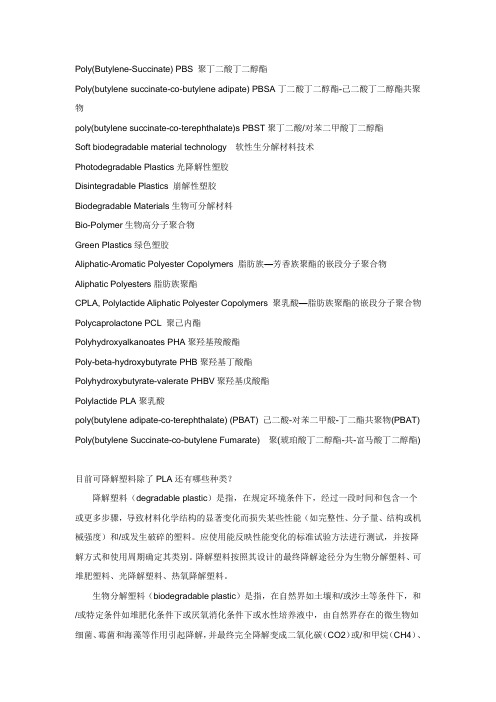
Poly(Butylene-Succinate) PBS 聚丁二酸丁二醇酯Poly(butylene succinate-co-butylene adipate) PBSA丁二酸丁二醇酯-己二酸丁二醇酯共聚物poly(butylene succinate-co-terephthalate)s PBST聚丁二酸/对苯二甲酸丁二醇酯Soft biodegradable material technology 软性生分解材料技术Photodegradable Plastics光降解性塑胶Disintegradable Plastics 崩解性塑胶Biodegradable Materials生物可分解材料Bio-Polymer生物高分子聚合物Green Plastics绿色塑胶Aliphatic-Aromatic Polyester Copolymers 脂肪族—芳香族聚酯的嵌段分子聚合物Aliphatic Polyesters脂肪族聚酯CPLA, Polylactide Aliphatic Polyester Copolymers 聚乳酸—脂肪族聚酯的嵌段分子聚合物Polycaprolactone PCL 聚己内酯Polyhydroxyalkanoates PHA聚羟基羧酸酯Poly-beta-hydroxybutyrate PHB聚羟基丁酸酯Polyhydroxybutyrate-valerate PHBV聚羟基戊酸酯Polylactide PLA聚乳酸poly(butylene adipate-co-terephthalate) (PBAT) 己二酸-对苯二甲酸-丁二酯共聚物(PBAT) Poly(butylene Succinate-co-butylene Fumarate) 聚(琥珀酸丁二醇酯-共-富马酸丁二醇酯)目前可降解塑料除了PLA还有哪些种类?降解塑料(degradable plastic)是指,在规定环境条件下,经过一段时间和包含一个或更多步骤,导致材料化学结构的显著变化而损失某些性能(如完整性、分子量、结构或机械强度)和/或发生破碎的塑料。
可生物降解聚乳酸外文翻译(中英文)
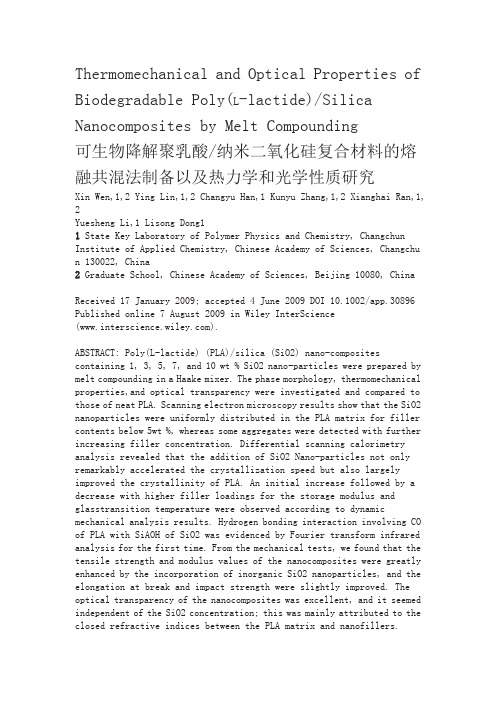
Thermomechanical and Optical Properties of Biodegradable Poly(L-lactide)/Silica Nanocomposites by Melt Compounding可生物降解聚乳酸/纳米二氧化硅复合材料的熔融共混法制备以及热力学和光学性质研究Xin Wen,1,2 Ying Lin,1,2 Changyu Han,1 Kunyu Zhang,1,2 Xianghai Ran,1, 2Yuesheng Li,1 Lisong Dong11 State Key Laboratory of Polymer Physics and Chemistry, Changchun Institute of Applied Chemistry, Chinese Academy of Sciences, Changchu n 130022, China2 Graduate School, Chinese Academy of Sciences, Beijing 10080, ChinaReceived 17 January 2009; accepted 4 June 2009 DOI 10.1002/app.30896 Published online 7 August 2009 in Wiley InterScience().ABSTRACT: Poly(L-lactide) (PLA)/silica (SiO2) nano-composites containing 1, 3, 5, 7, and 10 wt % SiO2 nano-particles were prepared by melt compounding in a Haake mixer. The phase morphology, thermomechanical properties,and optical transparency were investigated and compared to those of neat PLA. Scanning electron microscopy results show that the SiO2 nanoparticles were uniformly distributed in the PLA matrix for filler contents below 5wt %, whereas some aggregates were detected with further increasing filler concentration. Differential scanning calorimetry analysis revealed that the addition of SiO2 Nano-particles not only remarkably accelerated the crystallization speed but also largely improved the crystallinity of PLA. An initial increase followed by a decrease with higher filler loadings for the storage modulus and glasstransition temperature were observed according to dynamic mechanical analysis results. Hydrogen bonding interaction involving CO of PLA with SiAOH of SiO2 was evidenced by Fourier transform infrared analysis for the first time. From the mechanical tests, we found that the tensile strength and modulus values of the nanocomposites were greatly enhanced by the incorporation of inorganic SiO2 nanoparticles, and the elongation at break and impact strength were slightly improved. The optical transparency of the nanocomposites was excellent, and it seemed independent of the SiO2 concentration; this was mainly attributed to the closed refractive indices between the PLA matrix and nanofillers.©2009 Wiley Periodicals, Inc.J Appl Polym Sci 114: 3379–3388, 2009 Key words: nanocomposites; polyesters; silicas;transparency 通过哈克搅拌机用熔融法制备了含有1,3,5,7,和10%的纳米SiO2粒子的聚(L-乳酸)/二氧化硅(SiO2)纳米复合材料。
生物材料专业词汇中英文对照
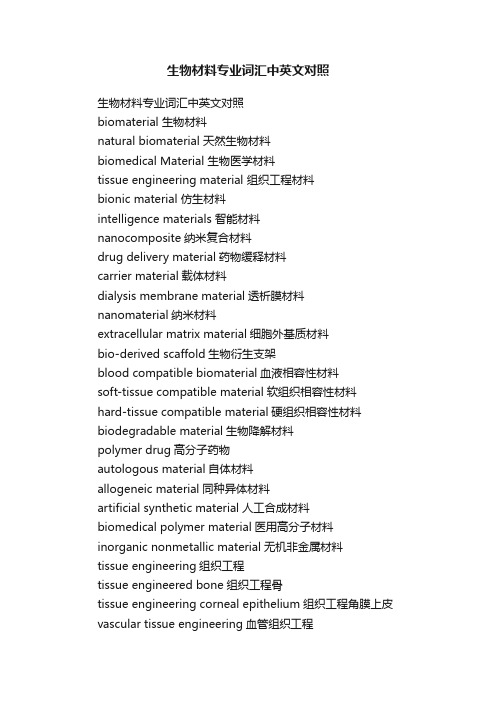
生物材料专业词汇中英文对照生物材料专业词汇中英文对照biomaterial 生物材料natural biomaterial 天然生物材料biomedical Material 生物医学材料tissue engineering material 组织工程材料bionic material 仿生材料intelligence materials 智能材料nanocomposite纳米复合材料drug delivery material药物缓释材料carrier material载体材料dialysis membrane material透析膜材料nanomaterial纳米材料extracellular matrix material细胞外基质材料bio-derived scaffold生物衍生支架blood compatible biomaterial血液相容性材料soft-tissue compatible material软组织相容性材料hard-tissue compatible material硬组织相容性材料biodegradable material生物降解材料polymer drug高分子药物autologous material自体材料allogeneic material同种异体材料artificial synthetic material人工合成材料biomedical polymer material医用高分子材料inorganic nonmetallic material无机非金属材料tissue engineering组织工程tissue engineered bone组织工程骨tissue engineering corneal epithelium组织工程角膜上皮vascular tissue engineering血管组织工程tissue engineering heart valve组织工程瓣膜tissue Engineered Medical Products组织工程医疗产品nerve tissue engineering神经组织工程tissue engineered cartilage组织工程软骨nanofiber scaffolds for liver tissue engineering肝脏组织工程纳米纤维支架vascularized tissue-engineered scaffold血管化组织工程骨支架tissue-engineered epidermis containing melanocyte含黑色素细胞的组织工程表皮tissue engineering models for cardiac muscle心肌组织的组织工程模型tissue-engineered tracheal epithelial cells组织工程化气管上皮细胞tissue-engineering skin scaffold material组织工程化皮肤支架材料fibers Tissue engineering scaffold纤维组织工程支架seed cell种子细胞salivary gland seed cell颌下腺种子细胞interstitial seed cell间质种子细胞cartilage seed cell软骨种子细胞seed cell bank种子细胞库tendon seeding cell肌腱种子细胞embryonic stem cell胚胎干细胞nerve stem cell神经干细胞adult Stem Cell成体干细胞cancer stem cell肿瘤干细胞adipose-derived stem cell脂肪干细胞bone marrow mesenchymal stem cell骨髓间充质干细胞hepatic stem cell ; liver stem cell肝干细胞hematopoietic stem cell造血干细胞peripheral blood hematopoietic stem cell transplantation外周血造血干细胞移植pluripotential hematopoietic stem cell多能造血干细胞multipotential hematopoietic stem cell全能造血干细胞umbilical cord blood transplantation脐带血造血干细胞移植induced pluripotent stem cell诱导多能干细胞endothelial progenitor cell内皮祖细胞材料表征方法rapidly quenching快速凝固法severe (intense) plastic deformation强烈塑性变形法amorphous solid crystallization 非晶晶化法in-situ composite原位复合法intercalation hybrids插层复合法micro emulsion微乳液法template synthesis模板合成法self-assembly自组装法graphite arc discharge石墨电弧放电法rapidly quenching 快速凝固法passivating treatment稳定化处理gas-condensatin method气体冷凝法liquid-phase method液相法solid-phase method固相法glucose-Fe complex coating糖铁络合物涂层surface modification表面修饰改性layer-by-layer self-assembly层层自组装inert gas deposition惰性气体沉积法high energy ball mill高能球磨法freeze drying冷冻干燥法hydrothermal synthesis水热合成法radiation chemical synthesis辐射化学合成法材料特性检测方法:field ion microscopy (FIM)场离子显微法magnetic force microscopy (MFM)磁力显微法laser interferometer激光干涉仪laser diffraction and scattering激光衍射/散射法centrifugal sedimentation离心沉降法X-ray diffractometry (XRD)X 射线衍射法scanning probe microscopy (SPM)扫描探针显微镜infrared absorption spectroscopy红外吸收光谱法X-ray diffractometry line broadening (XRD-LB) X 射线衍射线宽化法small angle X-ray scattering (SAXS) X 射线小角度散射法raman spectrometry拉曼光谱法mossbauer spectrometry穆斯堡尔谱法photon correlation spectroscopy光子相关谱法mercury porosimetry压汞仪法nano impress纳米压痕仪scanning tunneling electron microscopy (STM)扫描隧道电子显微法scanning near-field optical microscopy (SNOM)扫描近场光学显微法atomic force microscopy (AFM) 原子力显微法scanning capacitance microscopy (SCM)扫描电容显微法scanning thermal microscopy (STHM)扫描热显微法flexural strength抗折强度tensile strength抗拉强度compressive strength抗压强度hyperelastic 超弹性finite element 有限元biocompatibility生物相容性biomechanics生物力学slow release;controlled-release缓释slow release index缓释指数sustained release pellet缓释丸sustained release sponge缓释明胶hydroxycamptothecin Sustained-released Tablet羟基喜树碱缓释片sustained Release PLGA Microsphere PLGA生物可降解缓释微球slow-release Compound Acidifier缓释复合酸化剂drug sustained-release hydrogel film水凝胶药物缓释膜decellularized scaffold脱细胞支架acellular scaffolds matrix脱细胞支架材料homograft collagenous scaffold同种生物脱细胞支架decellularized scaffold of artery脱细胞动脉支架acellular vascular scaffold脱细胞血管支架cellularized nerve scaffold脱细胞神经支架acellular dermal scaffold脱细胞真皮支架decellularized vascular bioscaffold血管脱细胞生物支架acellular cartilage material脱细胞软骨支架材料detergent-extracted muscle scaffold脱细胞骨骼肌支架。
微塑料降解英语

微塑料降解英语Microplastics, tiny fragments of plastic less than 5 millimeters in size, have become a pervasive contaminant in our environment, affecting both terrestrial and aquatic ecosystems. These microplastics, often originating from the breakdown of larger plastic items, pose a significantthreat to biodiversity and human health due to theirability to accumulate toxins and enter the food chain. The degradation of microplastics, therefore, is a crucial aspect of addressing this global environmental issue.The degradation of microplastics is a complex process that involves both abiotic and biotic factors. Abiotic degradation refers to the breakdown of plastic by physical and chemical means, such as UV radiation, oxidation, and hydrolysis. However, these processes are often slow and inefficient, especially for microplastics, which are resistant to many forms of degradation.Biotic degradation, on the other hand, involves the breakdown of plastic by microorganisms. Bacteria, fungi, and algae can secrete enzymes that attack the polymer chains of plastic, eventually leading to its degradation.However, the rate of biodegradation is highly dependent on the type of plastic, its exposure to microorganisms, and the presence of suitable nutrients and oxygen.To accelerate the degradation of microplastics, several strategies have been proposed. One approach is to enhance the efficiency of biotic degradation by using specific microorganisms or enzymes. For instance, certain bacteria species have been found to be effective in degrading polyethylene terephthalate (PET), a common type of plastic. By isolating and culturing these bacteria, it is possible to increase their numbers and thereby accelerate the biodegradation process.Another strategy involves the development of novel materials that are easier to degrade than traditional plastics. These materials, known as biodegradable plastics, are designed to break down under specific environmental conditions, such as the presence of certain enzymes or microorganisms. While these materials are not yet widely used, they represent a promising area of research for addressing the issue of microplastic degradation.In addition to these strategies, it is also important to consider preventing the formation of microplastics in the first place. This can be achieved by improving waste management practices, reducing the use of single-use plastics, and promoting the recycling and reuse of plastic products. By reducing the amount of plastic entering the environment, we can minimize the formation of microplastics and thereby mitigate their environmental impact.In conclusion, the degradation of microplastics is a crucial aspect of addressing the global challenge ofplastic pollution. By combining abiotic and biotic degradation strategies, developing biodegradable plastics, and improving waste management practices, we can hope to reduce the impact of microplastics on our environment and protect the health of our ecosystems.**微塑料降解:全球挑战及其解决方案**微塑料,指尺寸小于5毫米的塑料碎片,已成为我们环境中无处不在的污染物,对陆地和水生生态系统构成严重威胁。
- 1、下载文档前请自行甄别文档内容的完整性,平台不提供额外的编辑、内容补充、找答案等附加服务。
- 2、"仅部分预览"的文档,不可在线预览部分如存在完整性等问题,可反馈申请退款(可完整预览的文档不适用该条件!)。
- 3、如文档侵犯您的权益,请联系客服反馈,我们会尽快为您处理(人工客服工作时间:9:00-18:30)。
Poly(Butylene-Succinate) PBS 聚丁二酸丁二醇酯
Poly(butylene succinate-co-butylene adipate) PBSA丁二酸丁二醇酯-己二酸丁二醇酯共聚物
poly(butylene succinate-co-terephthalate)s PBST聚丁二酸/对苯二甲酸丁二醇酯
Soft biodegradable material technology 软性生分解材料技术
Photodegradable Plastics光降解性塑胶
Disintegradable Plastics 崩解性塑胶
Biodegradable Materials生物可分解材料
Bio-Polymer生物高分子聚合物
Green Plastics绿色塑胶
Aliphatic-Aromatic Polyester Copolymers 脂肪族—芳香族聚酯的嵌段分子聚合物Aliphatic Polyesters脂肪族聚酯
CPLA, Polylactide Aliphatic Polyester Copolymers 聚乳酸—脂肪族聚酯的嵌段分子聚合物Polycaprolactone PCL 聚己内酯
Polyhydroxyalkanoates PHA聚羟基羧酸酯
Poly-beta-hydroxybutyrate PHB聚羟基丁酸酯
Polyhydroxybutyrate-valerate PHBV聚羟基戊酸酯
Polylactide PLA聚乳酸
poly(butylene adipate-co-terephthalate) (PBAT) 己二酸-对苯二甲酸-丁二酯共聚物(PBAT) Poly(butylene Succinate-co-butylene Fumarate) 聚(琥珀酸丁二醇酯-共-富马酸丁二醇酯)
目前可降解塑料除了PLA还有哪些种类?
降解塑料(degradable plastic)是指,在规定环境条件下,经过一段时间和包含一个或更多步骤,导致材料化学结构的显著变化而损失某些性能(如完整性、分子量、结构或机械强度)和/或发生破碎的塑料。
应使用能反映性能变化的标准试验方法进行测试,并按降解方式和使用周期确定其类别。
降解塑料按照其设计的最终降解途径分为生物分解塑料、可堆肥塑料、光降解塑料、热氧降解塑料。
生物分解塑料(biodegradable plastic)是指,在自然界如土壤和/或沙土等条件下,和/或特定条件如堆肥化条件下或厌氧消化条件下或水性培养液中,由自然界存在的微生物如细菌、霉菌和海藻等作用引起降解,并最终完全降解变成二氧化碳(CO2)或/和甲烷(CH4)、
水(H2O)及其所含元素的矿化无机盐以及新的生物质的塑料。
也就是通常所说的生物降解塑料。
生物分解塑料分类:按照原料组成和制造工艺不同可分为以下三种:天然高分子及其改性材料、微生物合成高分子材料和化学合成高分子材料。
目前具有应用前景的生物分解塑料有:聚3-羟基烷酸酯(PHA)、聚乳酸(PLA)、聚ε-己内酯(PCL)和聚丁二酸丁二醇酯(PBS)。
1.聚3-羟基烷酸酯(PHA)
聚羟基脂肪酸酯是由微生物通过各种碳源发酵而合成的不同结构的脂肪族共聚聚酯。
其中最常见的有聚3-羟基丁酸酯(PHB)、聚羟基戊酸酯(PHV)及PHB和PHV的共聚物(PHBV)。
PHB是一种在自然界中广泛存在的热塑性聚酯,尤其常在细菌细胞间发现。
PHB的许多物理性能和机械性能与聚丙烯塑料接近,但它具有生物降解性和生物相容性,在生物体内可完全降解成β-羟基丁酸、二氧化碳和水。
用这种生物塑料制成的材料可用于药物释放系统、植入体及一些痊愈后在人体中无害分解的器件,但相对聚丙烯来说,PHB比较硬,且更脆一些。
通过PHB与PHV共聚(PHBV)可以改善PHB结晶度高、较脆的弱点,提高其机械性、耐热性和耐水性。
PHB/PHV共聚物已经有产品出售,商品名为Biopol。
Biopol是由一系列不同材料组成的,当其中PHV的含量最高不超过30%,PHB/PHV为89/11时共聚物的强度和韧性达到最佳,此类产品可用于食品包装、化妆品、医药、卫生及农业等行业。
2.聚乳酸(PLA)
聚乳酸(PLA)是以微生物发酵产物-乳酸为单体化学合成的聚酯。
聚乳酸生产是以乳酸为原料。
传统的乳酸发酵大多用淀粉质原料。
目前美、法、日等国家已开发利用玉米、甘蔗、甜菜、土豆等农副产品为原料发酵生产乳酸,进而生产聚乳酸。
玉米是生物降解塑料聚乳酸的首选原料。
制造生物降解塑料聚乳酸的工艺过程如下:首先把玉米磨成粉,分离出淀粉,再从淀粉中提取出原始的葡萄糖,最后用类似啤酒的发酵工艺将葡萄糖转化成乳酸,再把提取出来的乳酸制成最终的聚合物—聚乳酸。
聚乳酸是由可再生资源如谷物生产的可生物降解的聚合物。
在聚乳酸生产路线中, 乳酸单体首先通过谷物淀物水解为葡萄糖, 葡萄糖由发酵过程转化为乳酸钠, 由此来制备。
乳酸进一步浓缩, 然后按照缩聚( 形成预聚合物) 、热解聚( 形成二丙交酯) 、开环聚合和解聚顺序进行聚合。
得到聚乳酸的分子量高达75000g/mol。
通过一般的方法进行乳酸缩聚反应,仅能得到乳酸低聚物。
目前研究最多的制备高分子量PLA的方法是通过丙交酯的开环聚合反应,而丙交酯则由乳酸低聚物经高温裂解合成。
对
于丙交酯的开环聚合反应机理及反应条件,都有详尽的研究报道。
最近,日本的三井化学公司提出了不经过丙交酯,直接以乳酸缩聚反应制备聚乳酸的新技术。
这一技术采用高活性的催化剂通过溶液缩聚,得到了高分子量的聚乳酸。
由于乳酸和丙交酯中含有不对称碳原子,经聚合可得到不同立构规整性的PLA,如L-PLA,D-PLA和DL-PLA。
聚乳酸有良好的防潮、耐油脂和密闭性,在常温下性能稳定,但在温度高于55℃或富氧及微生物的作用下会自动降解。
使用后它能被自然界中微生物完全降解,最终生成二氧化碳和水,不污染环境,这对保护环境非常有利。
聚乳酸的降解分成两个阶段:1)首先是纯化学水解成乳酸单体;2)乳酸单体在微生物的作用下降解成二氧化碳和水。
聚乳酸制成的食品杯只需60天就可以完全降解,真正达到生态和经济双重效应。
3.聚ε-己内酯(PCL)
聚ε-己内酯(PCL)是由ε-己内酯经开环聚合得到的低熔点聚合物,其熔点仅62℃。
PCL的降解性研究从1976年就已开始,在厌氧和需氧的环境中,PCL都可以被微生物完全分解。
与PLA相比,PCL具有更好的疏水性,但降解速度较慢;同时其合成工艺简单、成本较低。
PCL的加工性能优良,可用普通的塑料加工设备制成薄膜及其它制品。
同时,PCL和多种聚合物具有很好的相容性,如PE、PP、PVA、ABS、橡胶、纤维素及淀粉等,通过共混,以及共聚可得到性能优良的材料。
尤其是其与淀粉的共混或共聚,既可保持其生物降解性,又可降低成本,因而深受注目。
PCL与淀粉共混可得到耐水性好的降解塑料,其价格与纸张相近;利用原位聚合方法,可将ε-己内酯与淀粉接枝,得到性能优良的热塑性聚合物。
4.聚酯类--PBS/PBSA
与同类产品比较,聚酯生物分降塑料的优点:
1)上述生物分降塑料(聚乳酸、聚ε-己内酯、聚羟基烷基酸酯)的致命弱点之一就是耐热性差, 这影响了它在餐饮领域的应用推广。
2)上述生物分降塑料(聚乳酸、聚ε-己内酯、聚羟基烷基酸酯)加工工艺条件苛刻,产业化上存在一些无法的困难。
3)聚乳酸是水降解生物塑料,保存过程中不能接受水分子,在普通储存和正常使用过程中性能无法得到保证。
聚丁二酸丁二醇酯( PBS) 是典型的聚酯生物分降塑料,正是由于克服了以上弱点,成为生物降解塑料材料中的佼佼者, 用途极为广泛, 可用于包装、餐具、化妆品瓶及药品瓶、一次性医疗用品、农用薄膜、农药及化肥缓释材料、生物医用高分子材料等领域。
PBS 综合性能优异, 性价比合理, 具有良好的应用推广前景。
和PCL、PHB、PHA 等降解塑料相比, PBS 价格基本一致,没有什么优势;与其他生物降解塑料相比, PBS 力学性能优异, 接近PP 和ABS 塑料; 耐热性能好, 热变形温度接近100℃, 改性后使用温度可超过100℃, 可用于制备冷热饮包装和餐盒, 克服了其他生物降解塑料耐热温度低的缺点; 加工性能非常好, 可在现有塑料加工通用设备上进行各类成型加工, 是目前降解塑料加工性能最好的, 同时可以共混大量碳酸钙、淀粉等填充物, 得到价格低廉的制品; PBS 生产可通过对现有通用聚酯生产设备略作改造进行, 目前国内聚酯设备产能严重过剩, 改造生产PBS 为过剩聚酯设备提供了新的机遇。
另外, PBS 只有在堆肥等接触特定微生物条件下才发生降解, 在正常储存和使用过程中性能非常稳定。
PBS 以脂肪族丁二酸、丁二醇为主要生产原料的, 既可以通过石油化工产品满足需求, 也可通过淀粉、纤维素、葡萄糖等自然界可再生农作物产物, 经生物发酵途径生产, 从而实现来自自然、回归自然的绿色循环生产。
而且采用生物发酵工艺生产的原料, 还可大幅降低原料成本, 从而进一步降低PBS 成本。
参考资料《PBS资讯》
参考资料:/s/blog_69aca5730100k3m5.html。
